

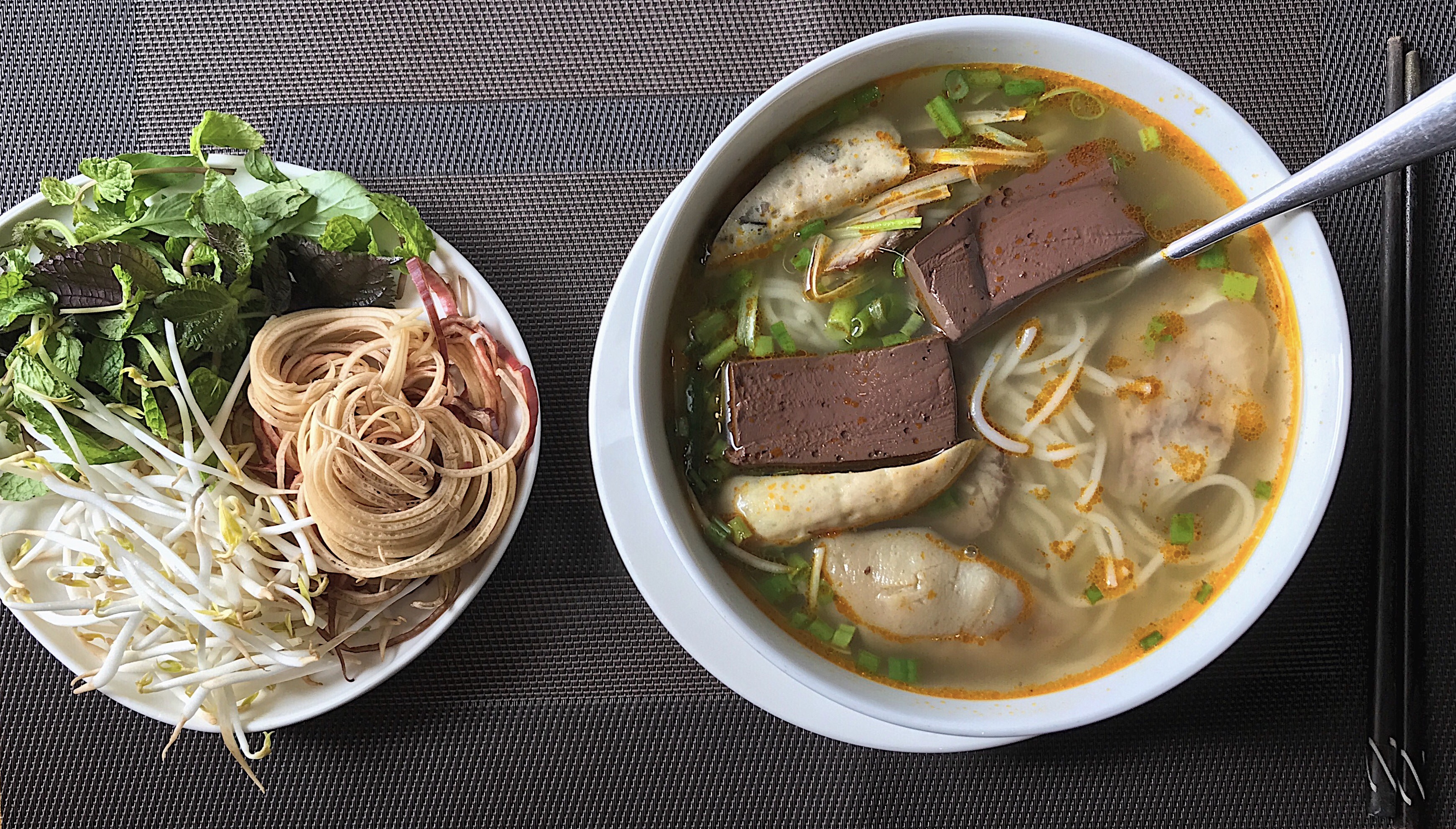
Vietnamese cuisine encompasses the foods and beverages of
Vietnam
Vietnam or Viet Nam ( vi, Việt Nam, ), officially the Socialist Republic of Vietnam,., group="n" is a country in Southeast Asia, at the eastern edge of mainland Southeast Asia, with an area of and population of 96 million, making ...
. Meals feature a combination of five fundamental tastes ( vi, ngũ vị, links=no, label=none): sweet, salty, bitter, sour, and
spicy. The distinctive nature of each dish reflects one or more elements (nutrients, colors, et cetera), which are also based around a
five-pronged philosophy. Vietnamese recipes use ingredients like
lemongrass
''Cymbopogon'', also known as lemongrass, barbed wire grass, silky heads, Cochin grass, Malabar grass, oily heads, citronella grass or fever grass, is a genus of Asian, African, Australian, and tropical island plants in the grass family.
Some ...
,
ginger
Ginger (''Zingiber officinale'') is a flowering plant whose rhizome, ginger root or ginger, is widely used as a spice and a folk medicine. It is a herbaceous perennial which grows annual pseudostems (false stems made of the rolled bases of ...
,
mint
MiNT is Now TOS (MiNT) is a free software alternative operating system kernel for the Atari ST system and its successors. It is a multi-tasking alternative to TOS and MagiC. Together with the free system components fVDI device drivers, XaAE ...
,
Vietnamese mint,
long coriander
''Eryngium foetidum'' is a tropical perennial herb in the family Apiaceae. Common names include culantro ( or ), recao, chadon beni (pronounced shadow benny), Mexican coriander, bhandhania, long coriander, sawtooth coriander, and ngò gai. It i ...
,
Saigon cinnamon,
bird's eye chili
Bird's eye chili or Thai chili (Thai: ''prik ki nu'', พริกขี้หนู, literally "mouse dung chili" owing to its shape) is a chili pepper, a variety from the species ''Capsicum annuum'' native to Mexico. Cultivated across Southea ...
,
lime, and
Thai basil leaves. Traditional Vietnamese cooking has often been characterised as using fresh ingredients, not using much dairy nor oil, having interesting textures, and making use of herbs and vegetables. The cuisine is also low in sugar and is almost always naturally
gluten-free
A gluten-free diet (GFD) is a nutritional plan that strictly excludes gluten, which is a mixture of proteins found in wheat (and all of its species and hybrids, such as spelt, kamut, and triticale), as well as barley, rye, and oats. The incl ...
, as many of the dishes are rice-based instead of wheat-based, made with
rice noodles
Rice noodles, or simply rice noodle, are noodles made with rice flour and water as the principal ingredients. Sometimes ingredients such as tapioca or corn starch are added in order to improve the transparency or increase the gelatinous and ch ...
,
papers and
flour
Flour is a powder made by grinding raw grains, roots, beans, nuts, or seeds. Flours are used to make many different foods. Cereal flour, particularly wheat flour, is the main ingredient of bread, which is a staple food for many cul ...
. Vietnamese cuisine is strongly influenced not only by the cuisines of neighboring China, Cambodia and Laos, but also by
French cuisine
French cuisine () is the cooking traditions and practices from France. It has been influenced over the centuries by the many surrounding cultures of Spain, Italy, Switzerland, Germany and Belgium, in addition to the food traditions of the re ...
due to
French colonial rule over the region from 1887 to 1954.
Kikkoman
is a Japanese food manufacturer. Its main products and services include soy sauce, food seasoning and flavoring, mirin, , and sake, juice and other beverages, pharmaceuticals, and restaurant management services.
Kikkoman has production pla ...
, a leading
soy sauce manufacturer, did market research confirming that
fish sauce () is the predominant
table sauce
A condiment is a preparation that is added to food, typically after cooking, to impart a specific flavor, to enhance the flavor, or to complement the dish. A table condiment or table sauce is more specifically a condiment that is served separat ...
in Vietnamese homes, where it captures over 70% of the market, while the share for soy sauce is under 20%.
Historical influences
Besides indigenous Vietnamese influences, which are the major core of Vietnamese food, owing to historical contact with China and centuries of
sinicization, some Vietnamese dishes share similarities with Chinese cuisine. In culinary traditions, the Chinese introduced to Vietnam several dishes, including ''vằn thắn''/''hoành thánh'' (
wonton), ''xá xíu'' (''
char siu''), ''há cảo'' (''
har gow
Har gow (sometimes anglicized as "ha gow", "haukau", "hakao"; ) is a traditional Cantonese dumpling served as dim sum.Hsiung, Deh-Ta. Simonds, Nina. Lowe, Jason. 005(2005). The food of China: a journey for food lovers. Bay Books. . p41.
Name
Th ...
''), ''hủ tiếu'' (''
shahe fen''), ''mì'' (wheat noodles), ''bò bía'' (''
popiah''), ''bánh quẩy'' (''
youtiao''),
mooncake
A mooncake () is a Chinese bakery product traditionally eaten during the Mid-Autumn Festival (中秋節). The festival is about lunar appreciation and Moon watching, and mooncakes are regarded as a delicacy. Mooncakes are offered between ...
and ''
bánh pía
Bánh bía, sometimes spelled bánh pía, is a type of Vietnamese cuisine bánh (translates loosely as "cake" or "bread"). A Suzhou style mooncake adapted from Teochew cuisine. The Vietnamese name comes from the Teochew word for pastry, "pia". ...
'' (Suzhou style mooncake), ''bánh tổ'' (''
nian gao
''Nian gao'' (年糕; also ''niangao''; ''nin4 gou1'' in Cantonese), sometimes translated as year cake or New Year cake or Chinese New Year's cake, is a food prepared from glutinous rice flour and consumed in Chinese cuisine. It is also simply ...
''), ''sủi dìn'' (
''tang yuan''), ''
bánh bò'', ''
bánh bao
''Bánh bao'' (literally "dumplings") is a Vietnamese bun based on the Cantonese ''da bao'' (大包, literally "big bun") brought to Vietnam by Cantonese immigrants. It is a ball-shaped bun containing pork or chicken meat, onions, eggs, mush ...
'' (''
baozi''), ''cơm chiên Dương Châu'' (
Yangzhou fried rice
Yangzhou fried rice (Traditional Chinese: 揚州炒飯; Simplified Chinese : 扬州炒饭; Pinyin : ''Yángzhōu chǎofàn,'' Jyutping: ''Joeng4zau1 Caau2faan6'') is a popular Chinese-style wok fried rice dish in many Chinese restaurants th ...
), and ''mì xào'' (
chow mein). The Vietnamese adopted these foods and added their own styles and flavors to the foods. Ethnic minorities in the mountainous region near the China–Vietnam border also adopted some foods from China. Ethnic
Tày and
Nùng in Lạng Sơn Province adopted ''thịt lợn quay'' (roasted pork) and ''khâu nhục'' (braised pork belly) from China. Some New World vegetables, such as chili peppers and corn (maize), also made their way to Vietnam from the
Ming dynasty
The Ming dynasty (), officially the Great Ming, was an Dynasties in Chinese history, imperial dynasty of China, ruling from 1368 to 1644 following the collapse of the Mongol Empire, Mongol-led Yuan dynasty. The Ming dynasty was the last ort ...
.
The French introduced baguettes to Vietnam, which were combined with Vietnamese stuffing to become a popular fast food in Vietnam called ''
bánh mì thịt,'' known overseas as "Vietnamese baguettes". ''Bánh mì'' is just the bread, whereas ''thịt'' implies meat or stuffing. The French also introduced Vietnam to onions, cauliflower, lettuce, potatoes, tarragon, carrot, artichoke, asparagus, and coffee.
The western introduced ingredients often have a name derived from a similar native Vietnamese ingredient, then adding the word ''tây'' (meaning ''western''). Onions are called ''hành tây'' (literally "western shallots"), asparagus as ''măng tây'' (western bamboo shoots) and potatoes are called ''khoai tây'' (western yam) in Vietnamese, which reflects their origin before arriving in Vietnam. French-influenced dishes are numerous and not limited to: ''sa lát'' (salad), ''
pâté'', ''
patê sô'' (a Brittany pasty called "pâté chaud"), ''bánh sừng trâu'' (croissant), ''bánh
flan'', y''a ua'' (yogurt), ''rôti'' (rotisserie), ''bơ'' (butter), ''vịt nấu cam'' (duck à l'orange), ''ốp lết'' (omelette), ''ốp la'' (''œufs au plat''), ''phá xí'' (farcies), ''bít tết'' (beefsteak), ''sốt vang'' (cooking with wine), ''dăm bông'' (''jambon''), and ''xúc xích'' (''saucisse''). Owing to influences from French colonial rule, the French Indochinese countries of Laos, Vietnam, and Cambodia have several shared dishes and beverages, including baguettes and coffee. The French also introduced the use of dairy products in Vietnamese-French fusion dishes.
Vietnamese cuisine also has influences from Champa, Malaysia and Cambodia. The use of coconut milk and various central dishes such as ''bánh khọt'' were influenced by Cham cuisine. Spices including curries were also introduced to Vietnam by Malay and Indian traders.
Though not common in the north, ''cà ri'' is a quite popular dish in central and southern Vietnam. The most common form is chicken curry, and to a lesser extent, goat curry. Chicken curry is an indispensable dish in many social gathering events, such as weddings, funerals, graduations, and the yearly death anniversary of a loved one. Similar to Cambodia, curry in Vietnam is eaten either with bread,
steamed rice, or round rice noodles (rice vermicelli). ''Mắm bồ hóc'' or
prahok, adopted from ethnic Khmer in Southern Vietnam, is used as a central ingredient of a Vietnamese rice noodle soup called ''bún nước lèo'' which originated with ethnic Khmers in Vietnam and is not found in Cambodia.
Owing to contact with previous communist countries from Eastern Europe, the Vietnamese adopted dishes such as stuffed cabbage soup, ''sa lát Nga'' (Russian salad) and ''bia Tiệp'' (Czech beer).
Regional cuisines
The mainstream culinary traditions in all three regions of
Vietnam
Vietnam or Viet Nam ( vi, Việt Nam, ), officially the Socialist Republic of Vietnam,., group="n" is a country in Southeast Asia, at the eastern edge of mainland Southeast Asia, with an area of and population of 96 million, making ...
share some fundamental features:
* Freshness of food: Most meats are only briefly cooked. Vegetables are eaten fresh; if they are cooked, they are boiled or only briefly stir-fried.
* Presence of herbs and vegetables: Herbs and vegetables are essential to many Vietnamese dishes and are often abundantly used.
* Variety and harmony of textures: Crisp with soft, watery with crunchy, delicate with rough.
* Broths or soup-based dishes are common in all three regions.
* Presentation: The condiments accompanying Vietnamese meals are usually colorful and arranged in eye-pleasing manners.
While sharing some key features, Vietnamese culinary tradition differs from region to region.
In
northern Vietnam
Northern Vietnam ( vi, Bắc Bộ) is one of three geographical regions within Vietnam. It consists of three administrative regions: the Northwest (Vùng Tây Bắc), the Northeast (Vùng Đông Bắc), and the Red River Delta (Đồng Bằng ...
, a colder climate limits the production and availability of spices. As a result, the foods there are often less spicy than those in other regions.
Black pepper
Black pepper (''Piper nigrum'') is a flowering vine in the family Piperaceae, cultivated for its fruit, known as a peppercorn, which is usually dried and used as a spice and seasoning. The fruit is a drupe (stonefruit) which is about in dia ...
is used in place of
chilies as the most popular ingredient to produce spicy flavors. In general, northern Vietnamese cuisine is not bold in any particular taste—sweet, salty, spicy, bitter, or sour. Most northern Vietnamese foods feature light and balanced flavors that result from subtle combinations of many different flavoring ingredients. The use of meats such as pork, beef, and chicken were relatively limited in the past. Freshwater fish,
crustacean
Crustaceans (Crustacea, ) form a large, diverse arthropod taxon which includes such animals as decapoda, decapods, ostracoda, seed shrimp, branchiopoda, branchiopods, argulidae, fish lice, krill, remipedes, isopoda, isopods, barnacles, copepods, ...
s, and
mollusk
Mollusca is the second-largest phylum of invertebrate animals after the Arthropoda, the members of which are known as molluscs or mollusks (). Around 85,000 extant species of molluscs are recognized. The number of fossil species is e ...
s, such as
prawns,
squid
True squid are molluscs with an elongated soft body, large eyes, eight arms, and two tentacles in the superorder Decapodiformes, though many other molluscs within the broader Neocoleoidea are also called squid despite not strictly fittin ...
s,
shrimp
Shrimp are crustaceans (a form of shellfish) with elongated bodies and a primarily swimming mode of locomotion – most commonly Caridea and Dendrobranchiata of the decapod order, although some crustaceans outside of this order are ref ...
s,
crab
Crabs are decapod crustaceans of the infraorder Brachyura, which typically have a very short projecting "tail" (abdomen) ( el, βραχύς , translit=brachys = short, / = tail), usually hidden entirely under the thorax. They live in all th ...
s,
clams, and
mussel
Mussel () is the common name used for members of several families of bivalve molluscs, from saltwater and freshwater habitats. These groups have in common a shell whose outline is elongated and asymmetrical compared with other edible clams, which ...
s, are widely used. Many notable dishes of
northern Vietnam
Northern Vietnam ( vi, Bắc Bộ) is one of three geographical regions within Vietnam. It consists of three administrative regions: the Northwest (Vùng Tây Bắc), the Northeast (Vùng Đông Bắc), and the Red River Delta (Đồng Bằng ...
are crab-centered (e.g., ''bún riêu''). Fish sauce,
soy sauce, prawn sauce, and limes are among the main flavoring ingredients. Being the cradle of Vietnamese civilization, northern Vietnam produces many signature dishes of Vietnam, such as ''
bún riêu
''Bún riêu'' is a traditional Vietnamese soup of clear stock and rice vermicelli. There are several varieties of ''bún riêu'', including ''bún riêu cua'' (minced crab), ''bún riêu cá'' (fish) and ''bún riêu ốc'' (snail). Vietweek ...
'' and ''
bánh cuốn'', which were carried to central and southern Vietnam through Vietnamese migration. Other famous Vietnamese dishes that originated from the north, particularly from
Hanoi
Hanoi or Ha Noi ( or ; vi, Hà Nội ) is the capital and second-largest city of Vietnam. It covers an area of . It consists of 12 urban districts, one district-leveled town and 17 rural districts. Located within the Red River Delta, Hanoi i ...
include "
''bún chả''" (rice noodle with grilled marinated pork), ''phở gà'' (chicken soup with rice noodles),
''chả cá Lã Vọng'' (rice noodle with grilled fish).
The abundance of spices produced by
Central Vietnam
Central Vietnam ( vi, Trung Bộ or ), also known as Middle Vietnam or The Middle, formerly known as by South Vietnam, and Annam under French Indochina, is one of the three geographical regions within Vietnam.
The name Trung Bộ was used b ...
's mountainous terrain makes this region's cuisine notable for its spicy food, which sets it apart from the two other regions of Vietnam, where foods are mostly not spicy. Once the capital of the last dynasty of Vietnam, ''
Huế
Huế () is the capital of Thừa Thiên Huế province in central Vietnam and was the capital of Đàng Trong from 1738 to 1775 and of Vietnam during the Nguyễn dynasty from 1802 to 1945. The city served as the old Imperial City and admi ...
s culinary tradition features highly decorative and colorful food, reflecting the influence of ancient Vietnamese royal cuisine. The region's cuisine is also notable for its sophisticated meals consisting of many complex dishes served in small portions. Chili peppers and shrimp sauces are among the frequently used ingredients. Some Vietnamese signature dishes produced in
central Vietnam
Central Vietnam ( vi, Trung Bộ or ), also known as Middle Vietnam or The Middle, formerly known as by South Vietnam, and Annam under French Indochina, is one of the three geographical regions within Vietnam.
The name Trung Bộ was used b ...
are ''
bún bò Huế
''Bún bò Huế'' (pronounced ) or ''bún bò'' () is a popular Vietnamese rice noodle (''bún'') dish with sliced beef (''bò''), chả lụa, and sometimes pork knuckles. The dish originates from Huế, a city in central Vietnam associated w ...
'' and
bánh khoái.
The warm weather and fertile soil of
southern Vietnam create an ideal condition for growing a wide variety of fruits, vegetables, and livestock. As a result, foods in southern Vietnam are often vibrant and flavorful, with liberal uses of garlic,
shallots, and fresh herbs. Sugar is added to food more than in the other regions. The preference for sweetness in southern Vietnam can also be seen through the widespread use of coconut milk in southern Vietnamese cuisine. Vast shorelines make seafood a natural staple for people in this region. Some signature seafood dishes from southern Vietnam include ''
bánh khọt'' and ''
bún mắm
''Bún mắm'' is a fermented thick Vietnamese vermicelli soup sometimes called "Vietnamese gumbo."
Etymology
Food reviewer Mike Sula explains, "''Bun'' refers to the steamed rice vermicelli, which can be a bit mushy. But the key to this sou ...
''.
The
Mekong Delta
The Mekong Delta ( vi, Đồng bằng Sông Cửu Long, lit=Nine Dragon River Delta or simply vi, Đồng Bằng Sông Mê Kông, lit=Mekong River Delta, label=none), also known as the Western Region ( vi, Miền Tây, links=no) or South-weste ...
cuisine relies heavily on fresh products which is abundant in the new land with heavy use of palm sugar, fermented fishes, seafoods and wild herbs and flowers. The history of the region being a newly settled area reflects on its cuisine, with ''Ẩm thực khẩn hoang'' or Settlers cuisine means dishes are prepared fresh from wild and newly-caught ingredients. The cuisine is also influenced by Khmer, Cham and Chinese settlers.
The cuisine of the Northern and Central Highlands regions is influenced by tribal traditions, with items such as thắng cố (Hmong horse stew), dried meats, ''
cơm lam'' and ''
rượu cần
''Rượu cần'' ( or 'straw liquor') is a fermented rice wine indigenous to several ethnic groups in Vietnam, in areas such as Tây Nguyên or Tây Bắc. It is made of fermented glutinous rice (''nếp'') mixed with several kinds of herbs ...
''.
Relation to Vietnamese philosophy
Vietnamese cuisine always has
five elements which are known for its balance in each of these features.
* Many Vietnamese dishes include five fundamental taste senses (): spicy (metal), sour (wood), bitter (fire), salty (water) and sweet (earth), corresponding to five organs ():
gall bladder,
small intestine
The small intestine or small bowel is an organ (anatomy), organ in the human gastrointestinal tract, gastrointestinal tract where most of the #Absorption, absorption of nutrients from food takes place. It lies between the stomach and large intes ...
,
large intestine,
stomach, and
urinary bladder
The urinary bladder, or simply bladder, is a hollow organ in humans and other vertebrates that stores urine from the kidneys before disposal by urination. In humans the bladder is a distensible organ that sits on the pelvic floor. Urine ente ...
.
* Vietnamese dishes also include five types of nutrients (): powder, water or liquid, mineral elements, protein, and fat.
* Vietnamese cooks try to have five colours (): white (metal), green (wood), yellow (earth), red (fire) and black (water) in their dishes.
* Dishes in Vietnam appeal to gastronomes via the five senses (): food arrangement attracts eyes, sounds come from crisp ingredients, five spices are detected on the tongue, aromatic ingredients coming mainly from herbs stimulate the nose, and some meals, especially finger food, can be perceived by touching.
Five-element correspondence

Vietnamese cuisine is influenced by the Asian principle of
five elements and ''
Mahābhūta''.
Yin-yang balance
The principle of
yin and yang
Yin and yang ( and ) is a Chinese philosophical concept that describes opposite but interconnected forces. In Chinese cosmology, the universe creates itself out of a primary chaos of material energy, organized into the cycles of yin and ya ...
( vi,
Âm dương) is applied in composing a meal in a way that provides a balance that is beneficial for the body. While contrasting texture and flavors are important, the principle primarily concerns the "heating" and "cooling" properties of ingredients. Certain dishes are served in their respective seasons to provide contrasts in temperature and spiciness of the food and environment.
Some examples are:
* Duck meat, considered "cool", is served during the hot summer with ginger
fish sauce, which is "warm". Conversely, chicken, which is "warm", and pork, which is "hot", are eaten in the winter.
* Seafoods ranging from "cool" to "cold" are suitable to use with
ginger
Ginger (''Zingiber officinale'') is a flowering plant whose rhizome, ginger root or ginger, is widely used as a spice and a folk medicine. It is a herbaceous perennial which grows annual pseudostems (false stems made of the rolled bases of ...
("warm").
* Spicy foods ("hot") are typically balanced with sourness, which is considered "cool".
*
Balut (), meaning "upside-down egg" ("cold"), must be combined with
Vietnamese mint () ("hot").
Food in relation to lifestyle



Vietnamese cuisine is reflective of the Vietnamese
lifestyle, from the preparation to how the food is served. Going through long phases of war and political conflict, as well as cultural shifts, the vast majority of the Vietnamese people have been living in poverty. Therefore, the ingredients for Vietnamese food are often very inexpensive but nonetheless, the way they are cooked together to create a
yin–yang balance makes the food simple in appearance but rich in flavor.
Because of economic conditions, maximizing the use of ingredients to save money has become a tradition in Vietnamese cooking. In earlier decades and even nowadays in rural areas, every part of a cow is used, from the muscle meat to the intestines; nothing is wasted. The higher quality cuts from farmed animals (cows, pigs) would be cooked in stirfry, soup or other dishes, while the secondary cuts would be used in blood sausages or soup. The same goes for vegetables like
scallions: the leafy part is diced into small bits which are used to add flavor to the food while the crunchy stalk and roots are replanted.
(fish sauce) is the most commonly used and iconic
condiment in Vietnamese cooking. It is made from fermented raw fish and is served with most of the Vietnamese dishes. Vietnamese cuisines are not known for ingredients with top quality, but rather for the very inexpensive and simple scraps that are creatively mixed to create dishes with bold flavor. A traditional
southern Vietnamese meal usually includes (plain white rice), (
catfish
Catfish (or catfishes; order Siluriformes or Nematognathi) are a diverse group of ray-finned fish. Named for their prominent barbels, which resemble a cat's whiskers, catfish range in size and behavior from the three largest species alive, ...
in a clay pot), (
sour soup with
snakehead fish
The snakeheads are members of the freshwater perciform fish family Channidae, native to parts of Africa and Asia. These elongated, predatory fish are distinguished by their long dorsal fins, large mouths, and shiny teeth. They breathe air with ...
), and it would be incomplete without fish sauce served as a condiment. Dishes are prepared less with an appearance in mind but are served family-style to bring everyone together after a long day of work.
Despite being a small country in Southeast Asia, the foods from each region in Vietnam carry their distinctive and unique characteristics that reflect the geographical and living conditions of the people there. The traditional southern Vietnamese meal is made up of fresh ingredients that only the fertile
Mekong Delta
The Mekong Delta ( vi, Đồng bằng Sông Cửu Long, lit=Nine Dragon River Delta or simply vi, Đồng Bằng Sông Mê Kông, lit=Mekong River Delta, label=none), also known as the Western Region ( vi, Miền Tây, links=no) or South-weste ...
could provide, such as , and a wide range of tropical fruit like
mangosteen
Mangosteen (''Garcinia mangostana''), also known as the purple mangosteen, is a tropical evergreen tree with edible fruit native to tropical lands surrounding the Indian Ocean. Its origin is uncertain due to widespread prehistoric cultivation. ...
,
mango, and
dragon fruit. The southern-style diet is very 'green', with vegetables, fish and tropical fruits as the main ingredients.
Central Vietnam
Central Vietnam ( vi, Trung Bộ or ), also known as Middle Vietnam or The Middle, formerly known as by South Vietnam, and Annam under French Indochina, is one of the three geographical regions within Vietnam.
The name Trung Bộ was used b ...
is the region in which food is prepared with the strongest, boldest flavors. This region is constantly under harsh weather conditions throughout the year, so people there do not have as many green ingredients as others do in the north and south of Vietnam. Instead, the coastline around the central Vietnam area is known for its salt and fish sauce industries; these two condiments are central to their daily diets.
Northern Vietnam
Northern Vietnam ( vi, Bắc Bộ) is one of three geographical regions within Vietnam. It consists of three administrative regions: the Northwest (Vùng Tây Bắc), the Northeast (Vùng Đông Bắc), and the Red River Delta (Đồng Bằng ...
ese cuisine has a strong Chinese influence, and its iconic dish is . While rice is a staple in the southern Vietnamese diet, the north has a preference for noodles. Owing to the drastic differences in climate and lifestyles throughout the three main regions of Vietnam, the foods vary. Northern Vietnamese cooking is the least bold and spicy in flavor compared to the foods from central and southern Vietnam.
Typical Vietnamese family meal
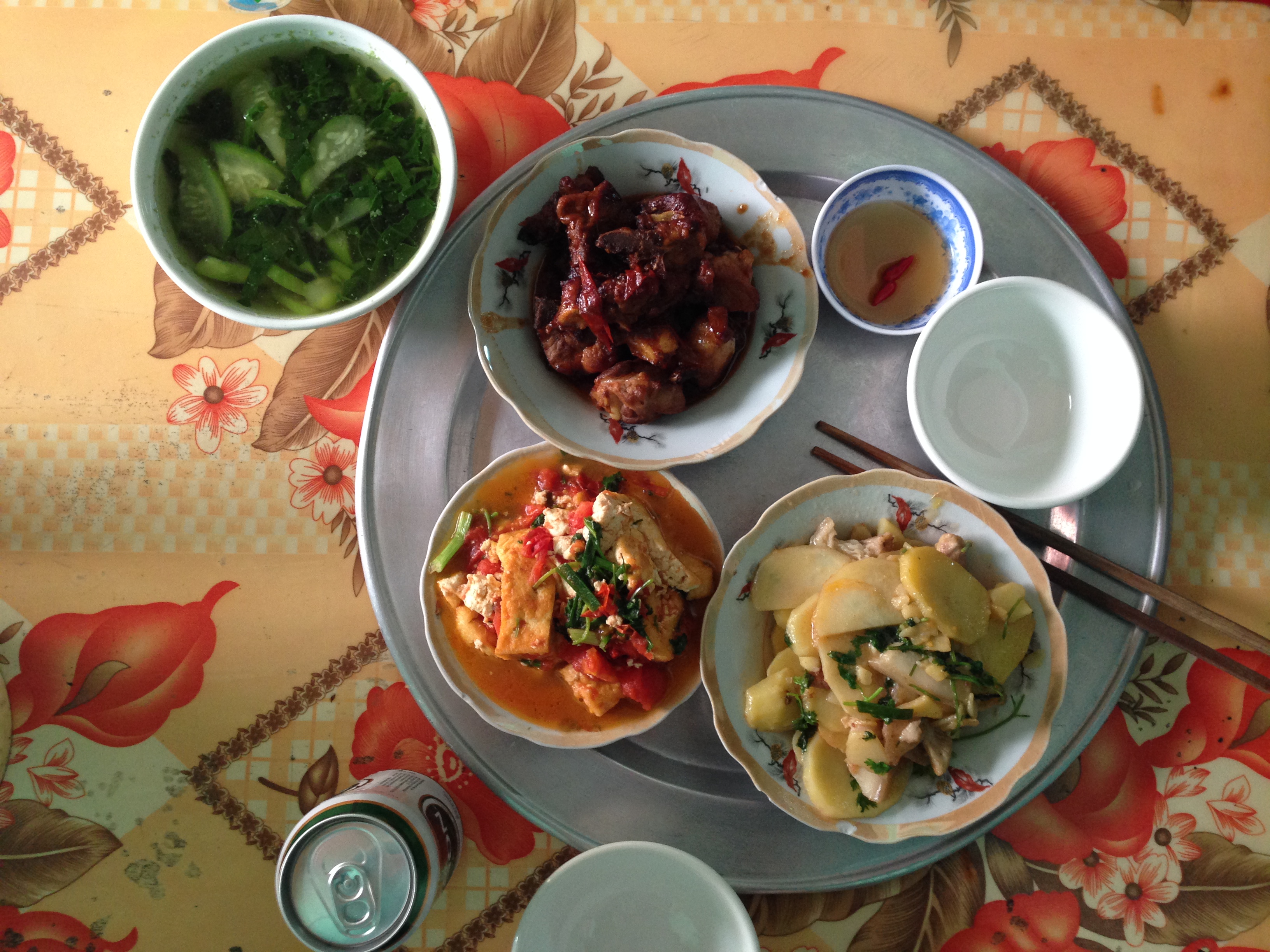
Daily meals of Vietnamese people quite differ from Vietnamese foods served in restaurants or stalls. A typical meal for the average Vietnamese family would include:
* ''Cơm trắng'': Cooked white rice
* ''Món mặn'' or main dishes to eat with rice: Fish/seafood, meat, tofu (grilled, boiled, steamed, stewed or stir-fried with vegetables)
* ''Rau'': Sauteed, boiled or raw fresh green vegetables
* ''Canh'' (a clear
broth with vegetables and often meat or seafood) or other kinds of soup
* ''
Nước chấm
(, Chữ Nôm: 渃㴨) is a common name for a variety of Vietnamese " dipping sauces" that are served quite frequently as condiments. It is commonly a sweet, sour, salty, savoury and/or spicy sauce.
(mixed fish sauce) is the most well kn ...
'': Dipping sauces and condiments depending on the main dishes, such as pure fish sauce, ginger fish sauce, tamarind fish sauce, soy sauce, ''muối tiêu chanh'' (salt and pepper with lime juice) or ''muối ớt'' (salt and chili)
* Small dish of relishes, such as salted eggplant, pickled white cabbage, pickled papaya, pickled garlic or pickled bean sprouts
* ''Tráng miệng'' or Desserts: Fresh fruits, drinks or sweets, such as ''
chè''.
Except individual bowls of rice, all dishes are communal and are to be shared in the middle of the table. It is also customary for younger people to ask/wait for the elders to eat first and the woman who sits right next to the rice pot serve rice for other people. People should "invite" the others to enjoy the meal (somehow similar to saying "Enjoy your meal"), in order from the elders to younger people. They also pick up food for each other as an action of care.
Feast

A feast ( vi, cỗ, ) is a significant event for families or villages, usually up to 12 people for each table. A feast is prepared for weddings, funerals, and festivals, including the longevity wishing ceremony. In a feast, ordinary foods are not served, but boiled rice is still used.
A Vietnamese feast has two courses: the main course ( – salty dish) and dessert ( – sweet dish). All dishes, except for individual bowls of rice, are enjoyed collectively. All main course dishes are served simultaneously rather than one after another. The major dish of the main course is placed in the center of the tables, usually big pots of soup or a hot pot.
A basic feast () consists of 10 dishes: five in bowls (): (fried fish belly), (
cellophane noodles
Cellophane noodles, or fensi (), sometimes called glass noodles, are a type of transparent noodle made from starch (such as mung bean starch, potato starch, sweet potato starch, tapioca, or canna starch) and water. A stabilizer such as chitosan ...
), (bamboo shoot), (
meatball), or (bird or chicken stew dishes) and five on plates (): (Vietnamese sausage), , or (boiled chicken or duck), (Vietnamese salad) and (stir-fried dishes). This kind of feast is traditional and is organized only in northern Vietnam. Other variations are found in central and southern Vietnam.
Four dishes essential in the feast of Tết are (spring rolls), (in northern Vietnam, refers to a spring roll called or ; in southern Vietnam, mainly refer to , fermented pork rolls), (stew dishes) and (noodle soup). At this time, the feast for offering ancestors includes sticky rice, boiled chicken, Vietnamese rice wine, and other preferred foods by ancestors in the past. Gifts are given before guests leave the feast.
Royal cuisine

In the Nguyễn dynasty, the 50 best chefs from all over the kingdom were selected for the board to serve the king. There were three meals per day—12 dishes at breakfast and 66 dishes for lunch and dinner (including 50 main dishes and 16 sweets). An essential dish was
bird's nest soup (). Other dishes included shark fin (),
abalone
Abalone ( or ; via Spanish , from Rumsen ''aulón'') is a common name for any of a group of small to very large marine gastropod molluscs in the family Haliotidae. Other common names are ear shells, sea ears, and, rarely, muttonfish or mutto ...
(), deer's tendon (), bears' hands (), and rhinoceros' skin (). Water had to come from the well, the pagoda, the well (near the base of ' mountain), or from the source of the River. Rice was the variety from the imperial rice field. clay pots for cooking rice were used only a single time before disposal. No one was allowed to have any contact with the cooked dishes except for the cooks and board members. The dishes were first served to eunuchs, then the king's wives, after which they were offered to the king. The king enjoyed meals () alone in a comfortable, music-filled space.
Cultural importance
Salt
Salt is a mineral composed primarily of sodium chloride (NaCl), a chemical compound belonging to the larger class of salts; salt in the form of a natural crystalline mineral is known as rock salt or halite. Salt is present in vast quant ...
is used as the connection between the worlds of the living and the dead. ''
Bánh phu thê
Bánh phu thê () or bánh xu xê, is a Vietnamese dessert made from rice with mung bean
The mung bean (''Vigna radiata''), alternatively known as the green gram, maash ( fa, ماش٫ )٫ mūng (), monggo, or munggo (Philippines), is a ...
'' is used to remind new couples of perfection and harmony at their weddings. Food is often placed at the ancestral altar as an offering to the dead on special occasions (such as
Lunar New Year
Lunar New Year is the beginning of a calendar year whose months are Lunar phase, moon cycles, based on the lunar calendar or lunisolar calendar.
The Lunar New Year as a celebration is observed by numerous cultures. It is also named "Chinese New ...
). Cooking and eating play an extremely important role in Vietnamese culture.
Proverbs
The word ''ăn'' (to
eat
Eating (also known as consuming) is the ingestion of food, typically to provide a heterotrophic organism with energy and to allow for growth. Animals and other heterotrophs must eat in order to survive — carnivores eat other animals, herbi ...
) is included in a great number of
proverbs and has a large range of semantic extensions.
* ("Checking the status of the rice pot when eating, watch where/what direction you are sitting.") = Be careful of possible faux pas.
* = living in accordance to one's limit and social circumstance
* ("The father eats salty food, the children go thirsty.") = Bad actions will later bring bad luck/consequences to descendants.
* ("Chewing carefully
akes onefeel full longer, ploughing deep is good for the rice") = Careful execution brings better results than hasty actions.
* ("Learning how to eat, how to speak, how to wrap, how to open") = Everything needs to be learned, even the simplest, start from "how to eat" politely.
Many Vietnamese idioms reflect the sex-is-eating mapping:
* ("He eats meatballs, she eats springrolls") = Both husband and wife are having affairs.
* ("Tired of rice, craving noodle soup") = A man gets bored of his wife and find another girl.
* ("You eat snack, you pay money") = Pay before having sex with prostitutes. (Long story short, ''bánh'' is a metaphor for the prostitute)
* ("Eating on the sly without cleaning your mouth") = Committing adultery but left trace
International popularity
Outside of Vietnam, Vietnamese cuisine is widely available in countries with strong Vietnamese immigrant communities, such as Australia, the United States, Canada, and France. Vietnamese cuisine is also popular in
Japan
Japan ( ja, 日本, or , and formally , ''Nihonkoku'') is an island country in East Asia. It is situated in the northwest Pacific Ocean, and is bordered on the west by the Sea of Japan, while extending from the Sea of Okhotsk in the n ...
,
Korea
Korea ( ko, 한국, or , ) is a peninsular region in East Asia. Since 1945, it has been divided at or near the 38th parallel, with North Korea (Democratic People's Republic of Korea) comprising its northern half and South Korea (Republic ...
, the
Czech Republic
The Czech Republic, or simply Czechia, is a landlocked country in Central Europe. Historically known as Bohemia, it is bordered by Austria to the south, Germany to the west, Poland to the northeast, and Slovakia to the southeast. The ...
,
Slovakia
Slovakia (; sk, Slovensko ), officially the Slovak Republic ( sk, Slovenská republika, links=no ), is a landlocked country in Central Europe. It is bordered by Poland to the north, Ukraine to the east, Hungary to the south, Austria to the ...
, Germany, United Kingdom, Poland, Philippines and Russia, and in areas with dense Asian populations.
Television shows featuring Vietnamese food have increased in popularity.
Luke Nguyen
Luke Nguyen ( vi, Luke Nguyễn; born 8 September 1978) is a Vietnamese–Australian chef and restaurateur, best known as the host of the television series, '' Luke Nguyen's Vietnam and Luke Nguyen's France''. The former is a food documentary in ...
from Australia currently features a television show, ''
Luke Nguyen's Vietnam'', dedicated on showcasing and instructing how to cook Vietnamese dishes.
On ''The Great Food Truck Race'', a Vietnamese sandwich truck called Nom Nom Truck received the most money in the first five episodes.
Anthony Bourdain wrote:
You don't have to go looking for great food in Vietnam. Great food finds you. It's everywhere. In restaurants, cafes, little storefronts, in the streets; carried in makeshift portable kitchens on yokes borne by women vendors. Your cyclo-driver will invite you to his home; your guide will want to bring you to his favorite place. Strangers will rush up and offer you a taste of something they're proud of and think you should know about. It's a country filled with proud cooks—and passionate eaters.
Gordon Ramsay
Gordon James Ramsay (; born ) is a British chef, restaurateur, television personality and writer. His restaurant group, Gordon Ramsay Restaurants, was founded in 1997 and has been awarded 17 Michelin stars overall; it currently holds a tot ...
visited Vietnam in his reality show ''
Gordon's Great Escape'' - S02E02 (2011) and fell in love with the taste of the culinary here. Especially the dish called
Hủ tiếu Mì by Mrs. Dì Hai, prepped and served on a small boat in Cái Răng floating market, Cần Thơ. He even praised it as "The greatest dish I have ever eaten" when he brought it up as one of the dishes for the elimination challenge for the top 5 finalists of
American MasterChef season 4 episode 21.
Cooking techniques
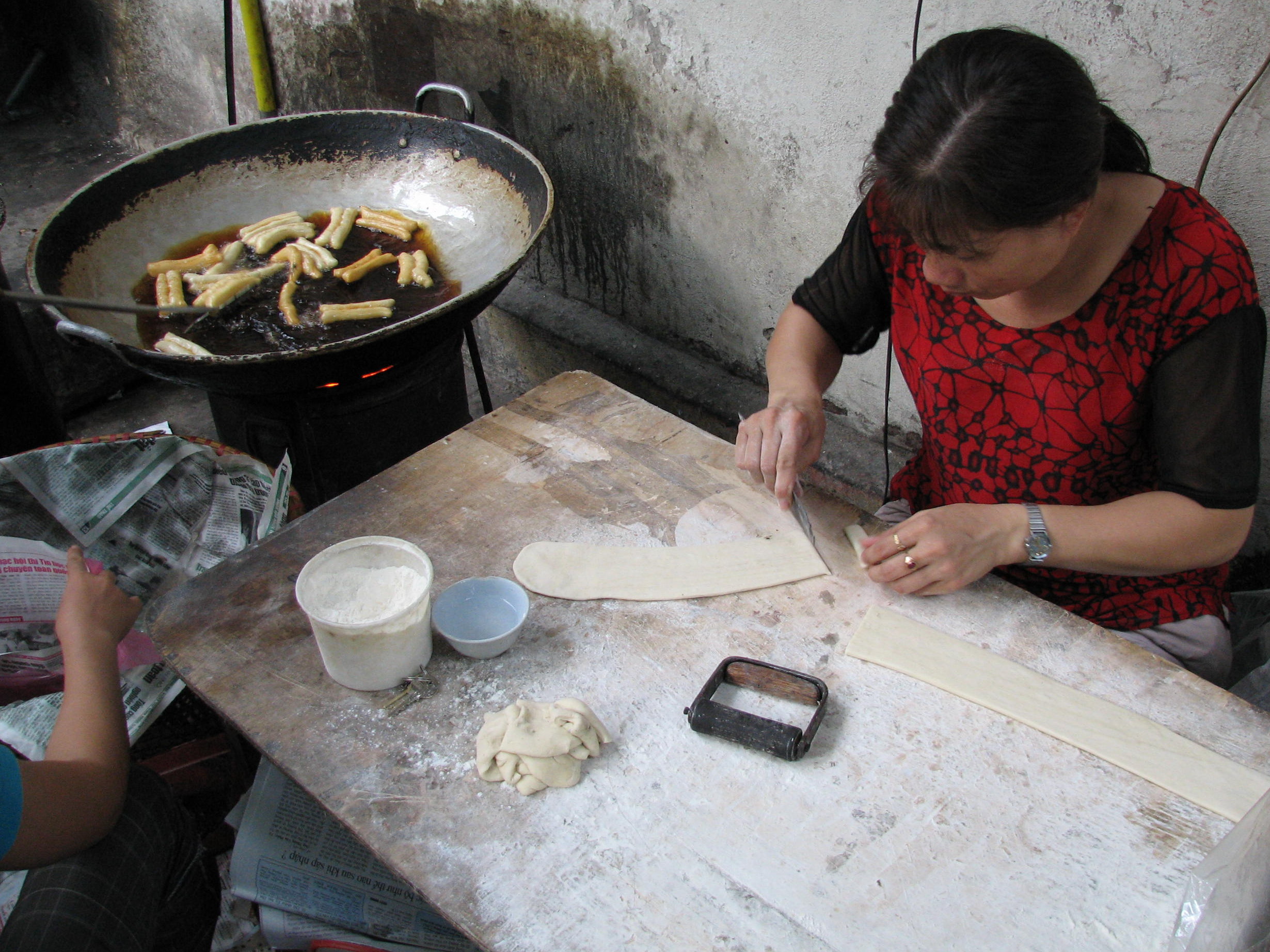


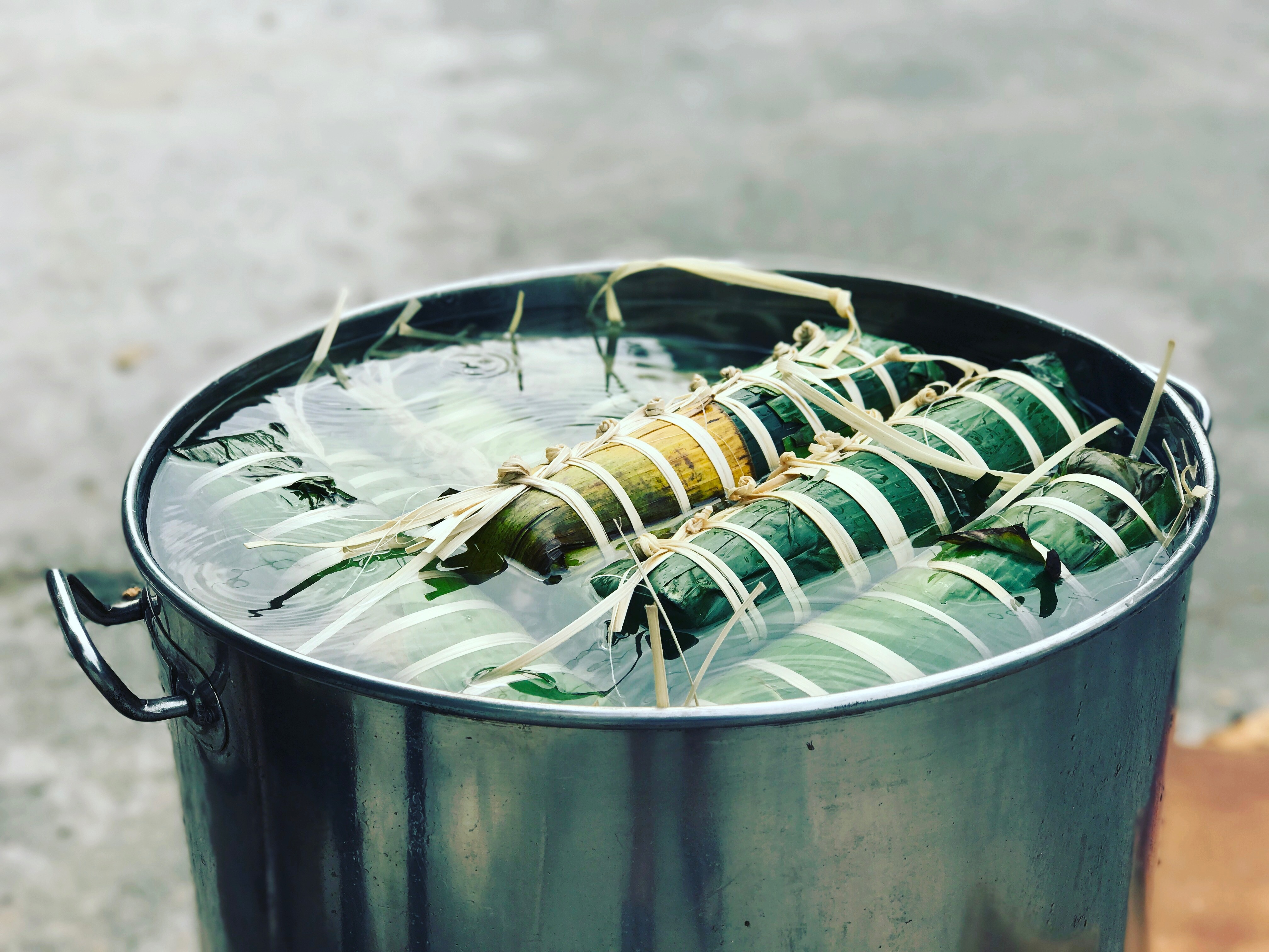

Some common Vietnamese
culinary
Culinary arts are the cuisine arts of food preparation, cooking and presentation of food, usually in the form of meals. People working in this field – especially in establishments such as restaurants – are commonly called chefs ...
terms include:
* ''Rán, chiên'' – fried dishes
** ''Chiên nước mắm'' – fried then tossed with fish sauce
** ''Chiên bột'' – battered then deep-fried
* ''Rang'' – dry-fried dishes with little to no oil
* ''Áp chảo'' – pan-fried then sautéed
* ''Xào'' – stir fry, sautéing
** ''Xào tỏi'' – stir fry with
garlic
Garlic (''Allium sativum'') is a species of bulbous flowering plant in the genus '' Allium''. Its close relatives include the onion, shallot, leek, chive, Welsh onion and Chinese onion. It is native to South Asia, Central Asia and northeas ...
, very common way of cooking vegetables
** ''Xào sả ớt'' – sautéed with
lemongrass
''Cymbopogon'', also known as lemongrass, barbed wire grass, silky heads, Cochin grass, Malabar grass, oily heads, citronella grass or fever grass, is a genus of Asian, African, Australian, and tropical island plants in the grass family.
Some ...
and
chili pepper
Chili peppers (also chile, chile pepper, chilli pepper, or chilli), from Nahuatl '' chīlli'' (), are varieties of the berry-fruit of plants from the genus ''Capsicum'', which are members of the nightshade family Solanaceae, cultivated for ...
** ''Xào lăn'' – pan searing or stir frying quickly to cook raw meat
** ''Xáo măng'' – braised or sautéed with
bamboo shoots
* ''Nhồi thịt'' – stuffed with minced meat before cooking
* ''Sốt chua ngọt'' – fried with sweet and sour sauce
* ''
Kho'' – stew, braised dishes
** ''Kho khô'' – literally dried stew (until the sauce thickens)
** ''Kho tiêu/kho gừng/kho riềng'' – stewed with
peppercorns/
ginger
Ginger (''Zingiber officinale'') is a flowering plant whose rhizome, ginger root or ginger, is widely used as a spice and a folk medicine. It is a herbaceous perennial which grows annual pseudostems (false stems made of the rolled bases of ...
/
galangal
* ''Nấu'' – means cooking, usually in a pot
** ''Nấu nước dừa'' – cooked with
coconut water
Coconut water (also coconut juice) is the clear liquid inside coconuts (fruits of the coconut palm). In early development, it serves as a suspension for the endosperm of the coconut during the nuclear phase of development. As growth continue ...
* ''Hầm/ninh'' – slow-cook with spices or other ingredients
* ''Canh'' – broth-like soup to be served over rice
* ''Rim'' – simmering
* ''Luộc'' – boiling with water, usually fresh vegetables and meat
* ''Chần'' – blanche
* ''Hấp'' – steamed dishes
** ''Hấp sả'' – steamed with
lemongrass
''Cymbopogon'', also known as lemongrass, barbed wire grass, silky heads, Cochin grass, Malabar grass, oily heads, citronella grass or fever grass, is a genus of Asian, African, Australian, and tropical island plants in the grass family.
Some ...
** ''Hấp Hồng Kông'' or ''hấp xì dầu'' – "Hong Kong-style" steamed dish (i.e.: with
scallion, ginger and
soy sauce)
* ''Om'' – clay pot cooking of northern style
** ''Om sữa'' – cooked in clay pot with milk
** ''Om chuối đậu'' – cooked with young banana and
tofu
* ''
Gỏi'' – salad dishes, usually with meat, fish
* ''Gói lá'' – wrap raw ingredients by a leaf (often banana) to form shape and enhance fragant
* ''Nộm'' – salads, usually meatless
* ''Nướng'' – grilled dishes
** ''Nướng xiên'' –
skewer
A skewer is a thin metal or wood stick used to hold pieces of food together. The word may sometimes be used as a metonym, to refer to the entire food item served on a skewer, as in "chicken skewers". Skewers are used while grilling or roasting ...
ed dishes
** ''Nướng ống tre'' – cooked in bamboo tubes over fire
** ''Nướng mọi/nướng trui/thui'' – char-grilled over open fire
** ''Nướng đất sét/lá chuối'' – cooked in a clay mould or banana leaves wrap, or recently, kitchen foil, hence the method has evolved into ''nướng giấy bạc''
** ''Nướng muối ớt'' – marinated with salt and chili pepper before being grilled
** ''Nướng tỏi'' – marinated with garlic then grilled
** ''Nướng mỡ hành'' – grilled then topped with melted lard,
peanut
The peanut (''Arachis hypogaea''), also known as the groundnut, goober (US), pindar (US) or monkey nut (UK), is a legume crop grown mainly for its edible seeds. It is widely grown in the tropics and subtropics, important to both small an ...
s, and chopped
green onions
* ''Bằm'' – sauteed mix of chopped ingredients
* ''Cháo'' –
congee
Congee or conjee ( ) is a type of rice porridge or gruel eaten in Asian countries. It can be eaten plain, where it is typically served with side dishes, or it can be served with ingredients such as meat, fish, seasonings and flavourings, most ...
dishes
* ''Súp'' –
soup
Soup is a primarily liquid food, generally served warm or hot (but may be cool or cold), that is made by combining ingredients of meat or vegetables with stock, milk, or water. Hot soups are additionally characterized by boiling soli ...
dishes (not ''canh'' or clear broth soup)
* ''Rô ti'' – roasting then simmering meat, usually with strong spices
* ''Tráng'' – spreading ingredient into a thin layer on a steamed/hot surface
* ''Cà ri'' – curry or curry-like dishes
* ''Quay'' – roasted dishes
* ''Lẩu'' –
hot pot dishes
* ''Nhúng dấm'' – cooked in a vinegar-based hot pot, some variations include vinegar and coconut water-based hot pot
* ''
Cuốn'' – any dish featuring
rice paper wraps with ''
bún'' and fresh herbs
* ''Bóp thấu''/''tái chanh'' – raw meat or seafood prepared with
lime or vinegar
Vietnamese utensils
Common ingredients
Vegetables
Fruits
Herbs (''rau thơm'')
Condiments and sauces
Condiments
Vietnamese usually use raw vegetables, ''rau sống'', or ''rau ghém'' (sliced vegetable) as condiments for their dishes to combine properly with each main dish in flavour. Dishes in which ''rau sống'' is indispensable are ''bánh xèo'' and hot pot. The vegetables principally are herbs and wild edible vegetables gathered from forests and family gardens. Leaves and buds are the most common parts of vegetables used. Most of the vegetables have medicinal value.
''Rau sống'' includes lettuce, raw bean sprout, herbs, shredded banana flower, green banana, water spinach, mango bud and guava leaves.
Herbs and spices
*
and
green onion leaves can be found in most Vietnamese dishes.
* A basic technique of stir-frying vegetable is frying garlic or
shallot with oil before putting the vegetable into the pan.
* In northern Vietnam, dishes with fish may be garnished with
dill.
* In central Vietnam, the mixture of ground lemongrass and chili pepper is frequently used in dishes with beef.
* In southern Vietnam, coconut water is used in most stew dishes.
* The pair
culantro (''ngò gai'') and
rice paddy herb (''ngò om'' or ''ngổ'') is indispensable in all kinds of sour soups in the southern Vietnam.
*
Spearmint is often used with strongly fishy dishes.
*
Perilla is usually used with crab dishes.
Pairing
* Chicken dishes are combined with
lime leaves.
* Crab and seashell dishes are combined with
fishy-smelling herb and
perilla.
* Dishes reputed as "cold" or "fishy-smelling", such as catfish, clams, or snails, are combined with ginger or lemongrass.
* Beef dishes are combined with celeries or pineapples.
Sauces
* ''
Nước chấm
(, Chữ Nôm: 渃㴨) is a common name for a variety of Vietnamese " dipping sauces" that are served quite frequently as condiments. It is commonly a sweet, sour, salty, savoury and/or spicy sauce.
(mixed fish sauce) is the most well kn ...
''
* ''
Mắm tôm'' (
shrimp paste)
* ''
Nước mắm'' (fish extract) can be used as it is or mixed with lemon juice, garlic, vinegar, sugar, and chili. This mixture is called
''nước mắm pha''.
* ''
Tương'' is made from fermented soybeans.
*
Soy sauce mostly is used in marinades and sauces.
*
Hoisin sauce is used in Southern Vietnam to mix with ''phở'' while serving.
* Hot chili sauce.
Food colourings

Traditionally, the colouring of Vietnamese food comes from natural ingredients, however today there's an increase in the use of artificial food dye agents for food colouring, in Vietnam.
* Red – usually from
beetroot
The beetroot is the taproot portion of a beet plant, usually known in North America as beets while the vegetable is referred to as beetroot in British English, and also known as the table beet, garden beet, red beet, dinner beet or golden bee ...
or by frying
annatto seeds to make oil (''dầu điều'')
* Orange – usually used for sticky rice, comes from ''
gac''
* Yellow – from
turmeric
Turmeric () is a flowering plant, ''Curcuma longa'' (), of the ginger family, Zingiberaceae, the rhizomes of which are used in cooking. The plant is a perennial, rhizomatous, herbaceous plant native to the Indian subcontinent and Southeast ...
* Green – from the
pandan leaf or ''
katuk''
* Purple – from the
magenta plant (''lá cẩm'')
* Black – in ''banh gai'' is from the
ramie leaf (''lá gai'')
* Dark brown – for stew dishes, uses ''nước màu'' or ''nước hàng'', which is made by heating sugar to a temperature above that of
caramel
Caramel ( or ) is an orange-brown confectionery product made by heating a range of sugars. It can be used as a flavoring in puddings and desserts, as a filling in bonbons, or as a topping for ice cream and custard.
The process of carameli ...
(170 °C).
Colourings can be absorbed by mixing ground colourings or colouring liquid or wrapping before boiling to get the extracts. When colouring dishes, the tastes and smells of colourings must also be considered.
Popular dishes
When Vietnamese dishes are referred to in English, it is generally by the Vietnamese name without the
diacritic
A diacritic (also diacritical mark, diacritical point, diacritical sign, or accent) is a glyph added to a letter or to a basic glyph. The term derives from the Ancient Greek (, "distinguishing"), from (, "to distinguish"). The word ''diacrit ...
s. Some dishes have gained descriptive English names, as well.
Popular Vietnamese dishes include:
Noodle soups
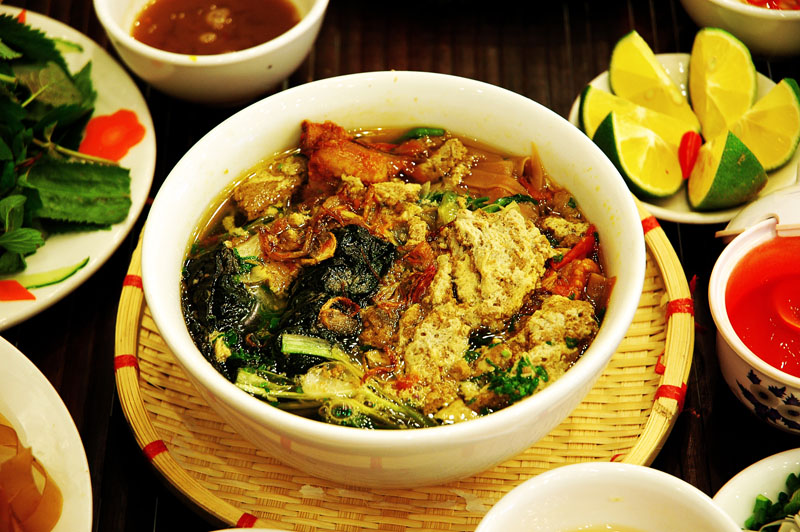
Vietnamese cuisine boasts a huge variety of noodle soups, each with distinct influences, origins and flavours. A common characteristic of many of these soups is a rich broth.
Soup and ''cháo'' (congees)

Rice dishes
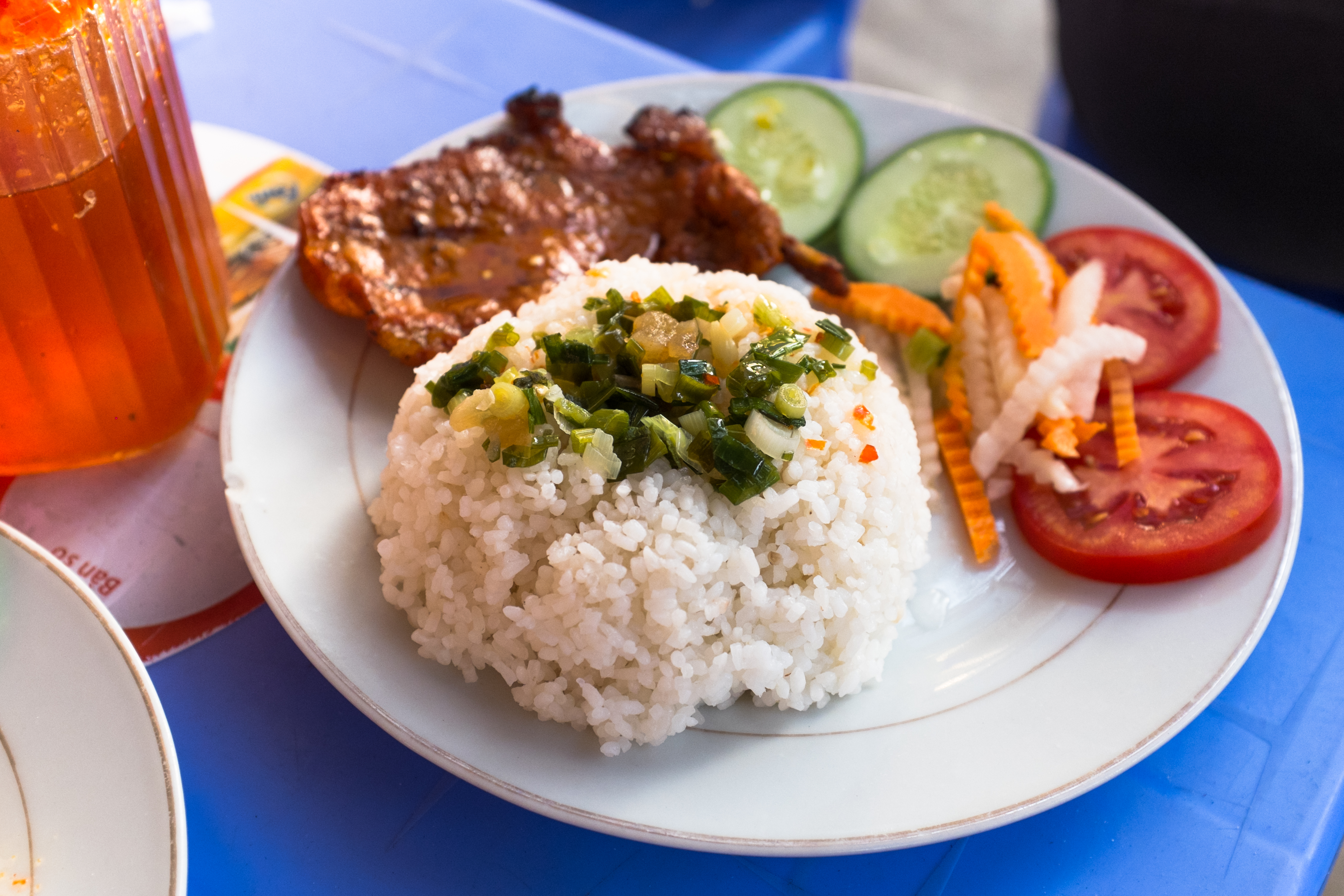
Sticky rice dishes

Bánh
The Vietnamese name for pastries is ''bánh''. Many of the pastries are wrapped in various leaves (bamboo, banana, ''dong'', ''gai'') and boiled or steamed. One of the historic dishes, dating to the mythical founding of the Vietnamese state is ''
bánh chưng''. As it is a savory dish and thus not a true pastry, ''bánh chưng'' and the accompanying ''bánh dày'' are laden with heaven and earth symbolism. These dishes are associated with offerings around the Vietnamese New Year (''Tết''). Additionally, as a legacy of French colonial rule and influence,
bûche de Noël
A Yule log or bûche de Noël () is a traditional Christmas cake, often served as a dessert near Christmas, especially in France, Belgium, Luxembourg, Switzerland, and several former French colonies such as Canada, Vietnam, and Lebanon. ...
is a popular dessert served during the Christmas season.

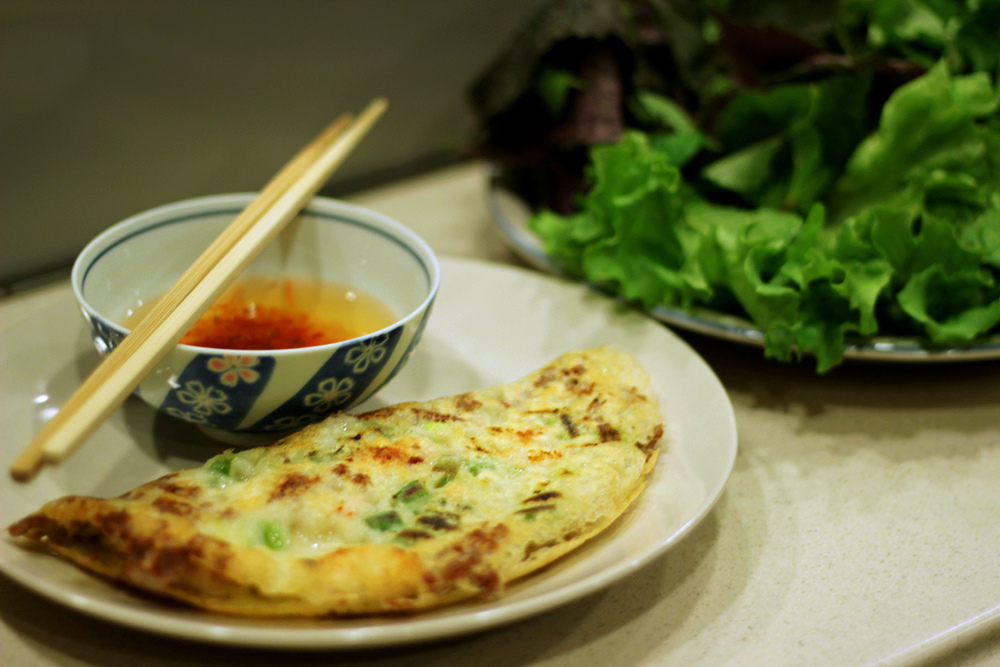
Wraps and rolls
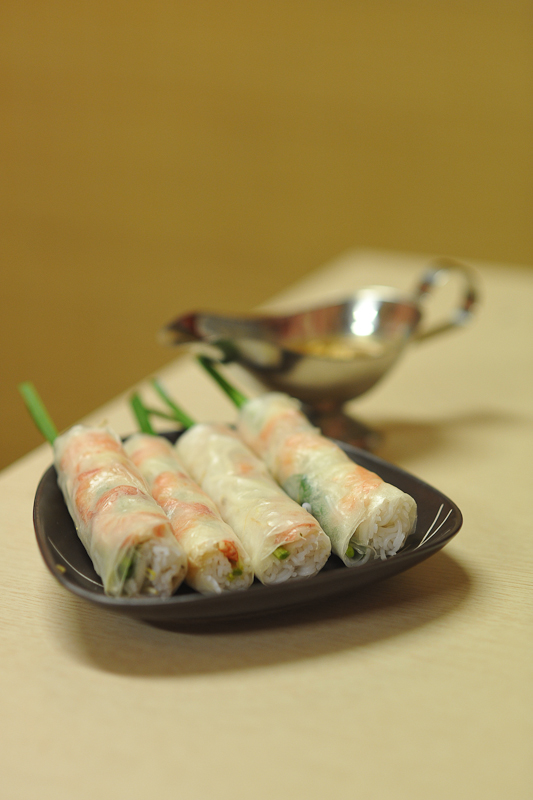
''
Bánh tráng'' can be understood as either of the following:
*
''Bánh tráng cuốn''
: Thin rice flour sheet dried into what is commonly called "rice paper", used in making
spring roll (''
chả giò''), and
summer rolls (''
gỏi cuốn'') by applying some water to soften the texture
* ''
Bánh tráng nướng'' (in the south), or ''bánh đa'' in the north
: These are large, round, flat rice
crackers, which, when heated, enlarge into round, easily shattered pieces. They can be eaten separately, although they are most commonly added into the
vermicelli
Vermicelli (; , , also , ) is a traditional type of pasta round in section similar to spaghetti. In English-speaking regions it is usually thinner than spaghetti, while in Italy it is typically thicker.
The term ''vermicelli'' is also used ...
noodle dishes like ''
cao lầu'' and ''
mì quảng''. Many types of ''
bánh tráng'' exist, including the clear
sesame
Sesame ( or ; ''Sesamum indicum'') is a flowering plant in the genus ''Sesamum'', also called benne. Numerous wild relatives occur in Africa and a smaller number in India. It is widely naturalized in tropical regions around the world and is cul ...
seed ones, prawn-like cracker with dried spring onions, and sweet milk.
Sandwiches and pastries
Meat dishes


Seafood dishes
Salads
''
Nộm'' (Northern dialects) or ''Gỏi'' (Southern dialects) is Vietnamese salad; of the many varieties, the most popular include:
Curries
* Vietnamese
curry
A curry is a dish with a sauce seasoned with spices, mainly associated with South Asian cuisine. In southern India, leaves from the curry tree may be included.
There are many varieties of curry. The choice of spices for each dish in trad ...
is also popular, especially in the center and south, owing to the cultural influence of Indian, Khmer and Malay traders.
* Another type of well-known Vietnamese curry is beef
brisket curry or
oxtail curry. The beef curries are often served with French bread for dipping, or with rice.
* '' Cà ri gà'' is a popular Vietnamese curry made with chicken, carrots, sweet potatoes, and peas in a
coconut curry sauce. It is also served with rice or baguette.
Preserved dishes
''Muối'' (literally means ''salting'') and ''chua'' (literally means ''sour'' or ''fermenting'') are Vietnamese term for preserved dishes. Monsoon tropical climate with abundant rainfall gives the Vietnamese a generous year-round supply of vegetables.
Animal husbandry
Animal husbandry is the branch of agriculture concerned with animals that are raised for meat, fibre, milk, or other products. It includes day-to-day care, selective breeding, and the raising of livestock. Husbandry has a long history, starti ...
never occurred in large scale in Vietnamese history, therefore, preserved dishes are mainly plant-based pickled dishes. Seafood is often made into a fermented form called ''mắm'' like
fish sauce.

Mắm
''Mắm'' is a Vietnamese term for fermented fish, shrimp or other aquatic ingredients. It is used as main course, as an ingredient or as condiment. The types of fish most commonly used to make ''mắm'' are
anchovies,
catfish
Catfish (or catfishes; order Siluriformes or Nematognathi) are a diverse group of ray-finned fish. Named for their prominent barbels, which resemble a cat's whiskers, catfish range in size and behavior from the three largest species alive, ...
,
snakeheads, and
mackerels. The fish flesh remains intact (this is how it is different from ''nước mắm''), and can be eaten cooked or uncooked, with or without vegetables and condiments.
Fish sauce is literally called "mắm water" in Vietnamese and is the distilled liquid from the process of fermentation of mắm.
Fermented meat dishes
''
Nem chua'', a Vietnamese
fermented meat served as is or fried, is made from pork meat, coated by fried rice (''thính gạo''), mixed with pork skin and then wrapped in
country gooseberry leaves (''lá chùm ruột'') or ''
Erythrina orientalis'' leaves (''lá vông nem''). The preservation process takes about three to five days.
Sausages
Vietnamese sausage, ''
giò'', is usually made from fresh ground pork and beef. Sausage makers may use the meat, skin or ear. Fish sauce is added before banana leaves are used to wrap the mixture. The last step is boiling. For common sausage, 1 kg of meat is boiled for an hour. For ''chả quế'', the boiled meat mixture will then be roasted with
cinnamon.
Vegetarian dishes
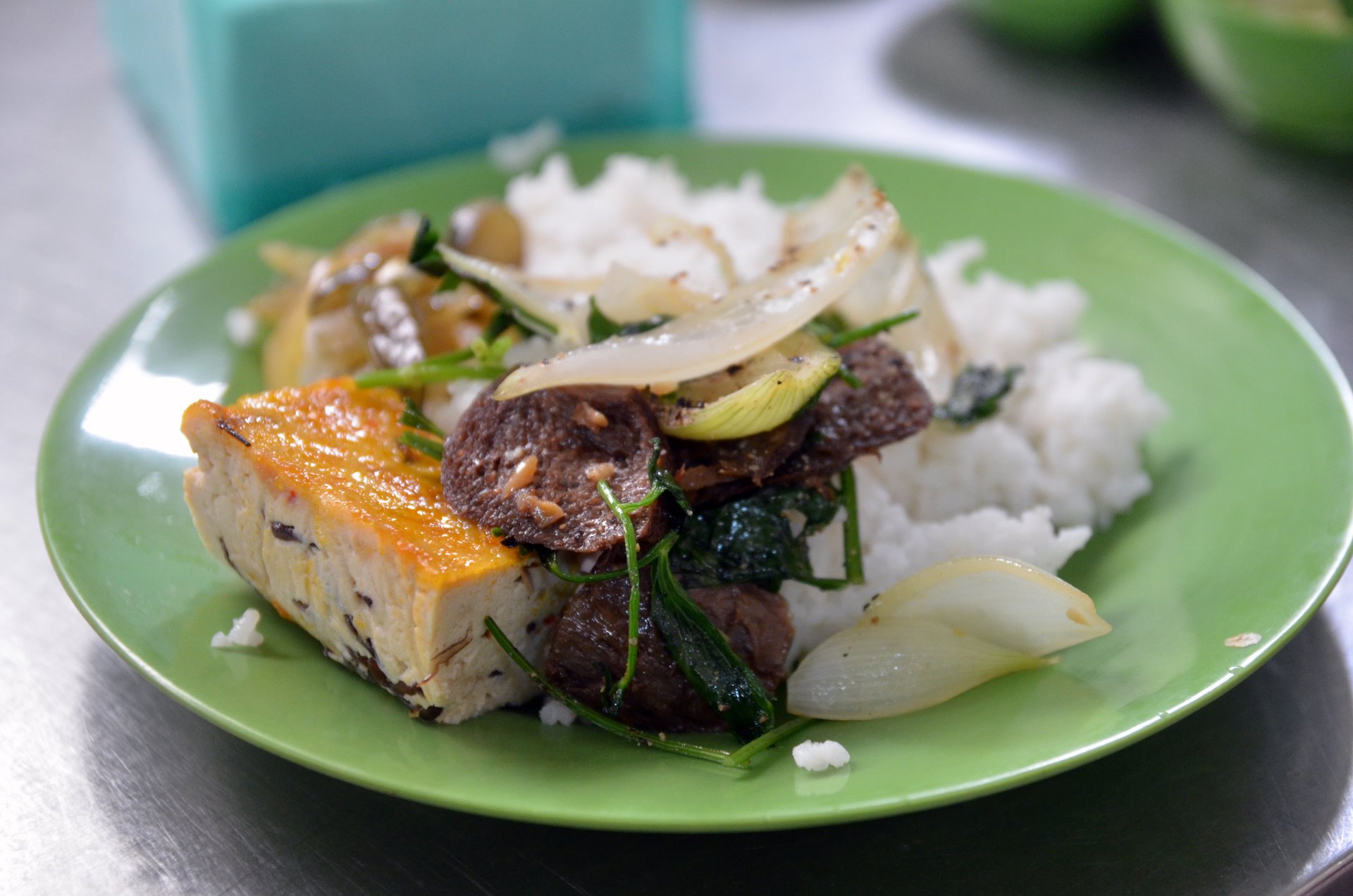
Vegetarian dishes in Vietnam often have the same names as their meat equivalents, e.g. ''phở bò,'' but with ''chay'' (vegetarian) sign in front, those dishes are served with tofu instead of meat. Nearly every soup, sandwich and street food has its vegetarian correspondent. Sometimes you can also see notations like ''"phở chay"'', ''"bánh mì chay"'' (vegetarian sandwich) or ''"cơm chay"'' (vegetarian rice). Vegetarian food in comparison the normal dishes are almost always cheaper, often half of the normal price. Vegetarian restaurants are mostly frequented by religious Vietnamese people and are rarely found in touristic areas. Vegetarian food is also eaten to earn luck during special holiday and festival, especially during Lunar New Year where Vietnamese culture serve vegetarian food regardless of their religion.
Desserts
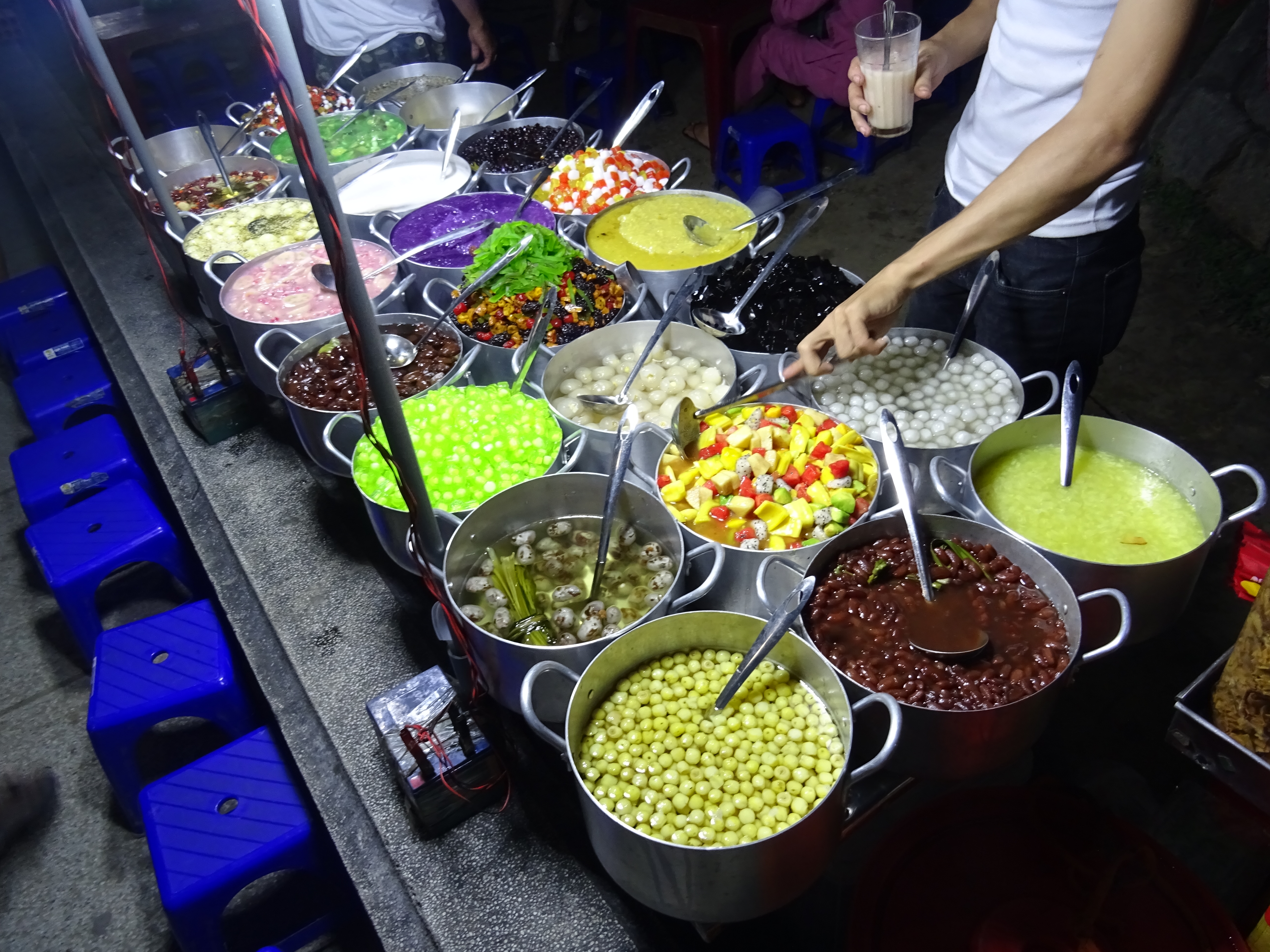
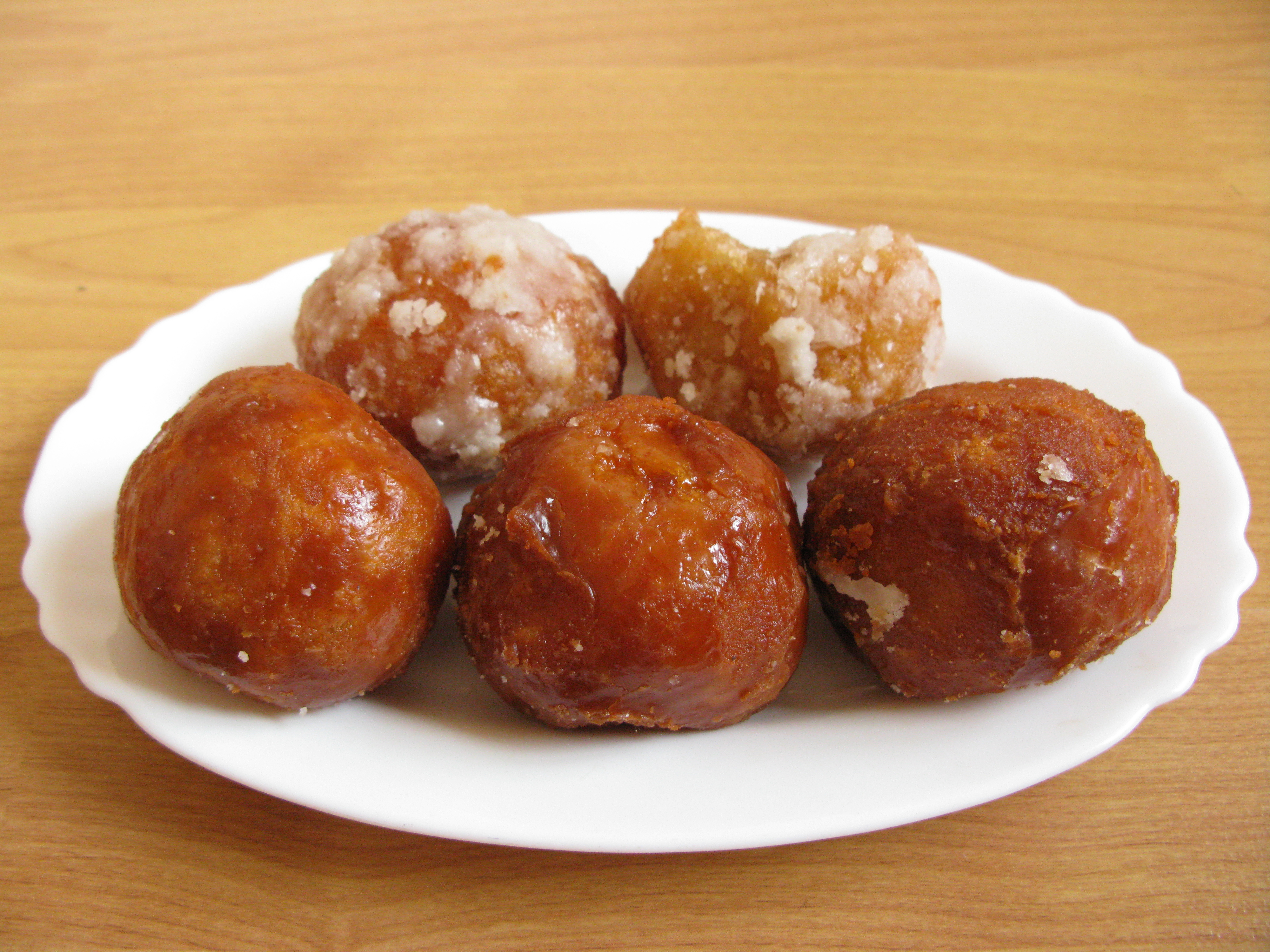
Mứt
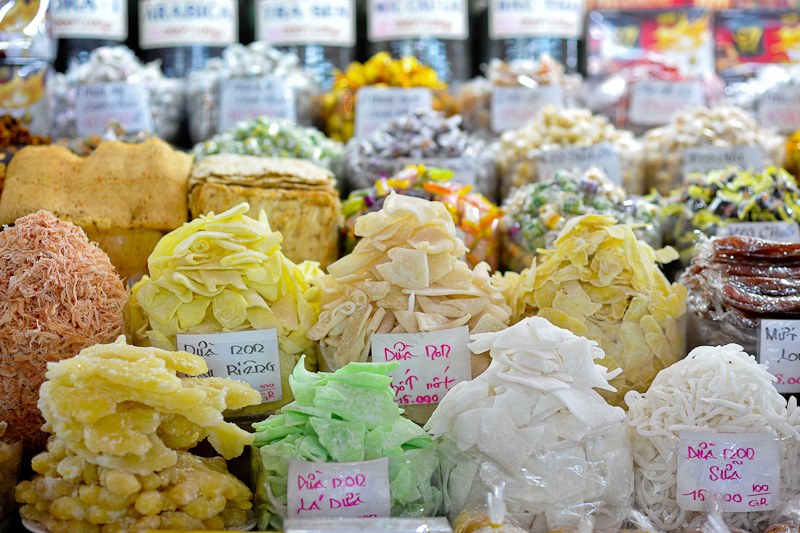
Vietnamese use fruits in season. When the season is passing, they make candied fruit, called ''ô mai'', and
fruit preserves, called ''mứt''. The original taste of ''ô mai'' is sour, sweet, salty, and spicy. The most famous kind of ''ô mai'' is ''ô mai mơ'', made from
apricot
An apricot (, ) is a fruit, or the tree that bears the fruit, of several species in the genus '' Prunus''.
Usually, an apricot is from the species '' P. armeniaca'', but the fruits of the other species in ''Prunus'' sect. ''Armeniaca'' are al ...
s harvested from the forest around
Perfume Pagoda (''Chùa Hương''),
Hà Tây Province. This ''ô mai'' consists of apricot covered by ginger, sugar, and
liquorice root slivers.
Tofu
Tofu (''đậu phụ'') is widely used in Vietnamese cuisine. It is boiled, fried (sprinkled with ground shrimp or oil-dipped minced
spring onion) or used as an ingredient in a variety of dishes.
Other
soybean
The soybean, soy bean, or soya bean (''Glycine max'') is a species of legume native to East Asia, widely grown for its edible bean, which has numerous uses.
Traditional unfermented food uses of soybeans include soy milk, from which tofu ...
products range from
soy sauce (''nước tương''; usually light soy sauce),
fermented bean paste
Fermented bean paste is a category of fermented foods typically made from ground soybeans, which are indigenous to the cuisines of East, South and Southeast Asia. In some cases, such as the production of ''miso'', other varieties of beans, such a ...
(''
tương''), and
fermented bean curd (''đậu phụ nhự'' or ''chao'') to douhua (soft tofu sweet soup; ''tàu hũ nước đường'' or ''tào phớ'').
Exotic dishes

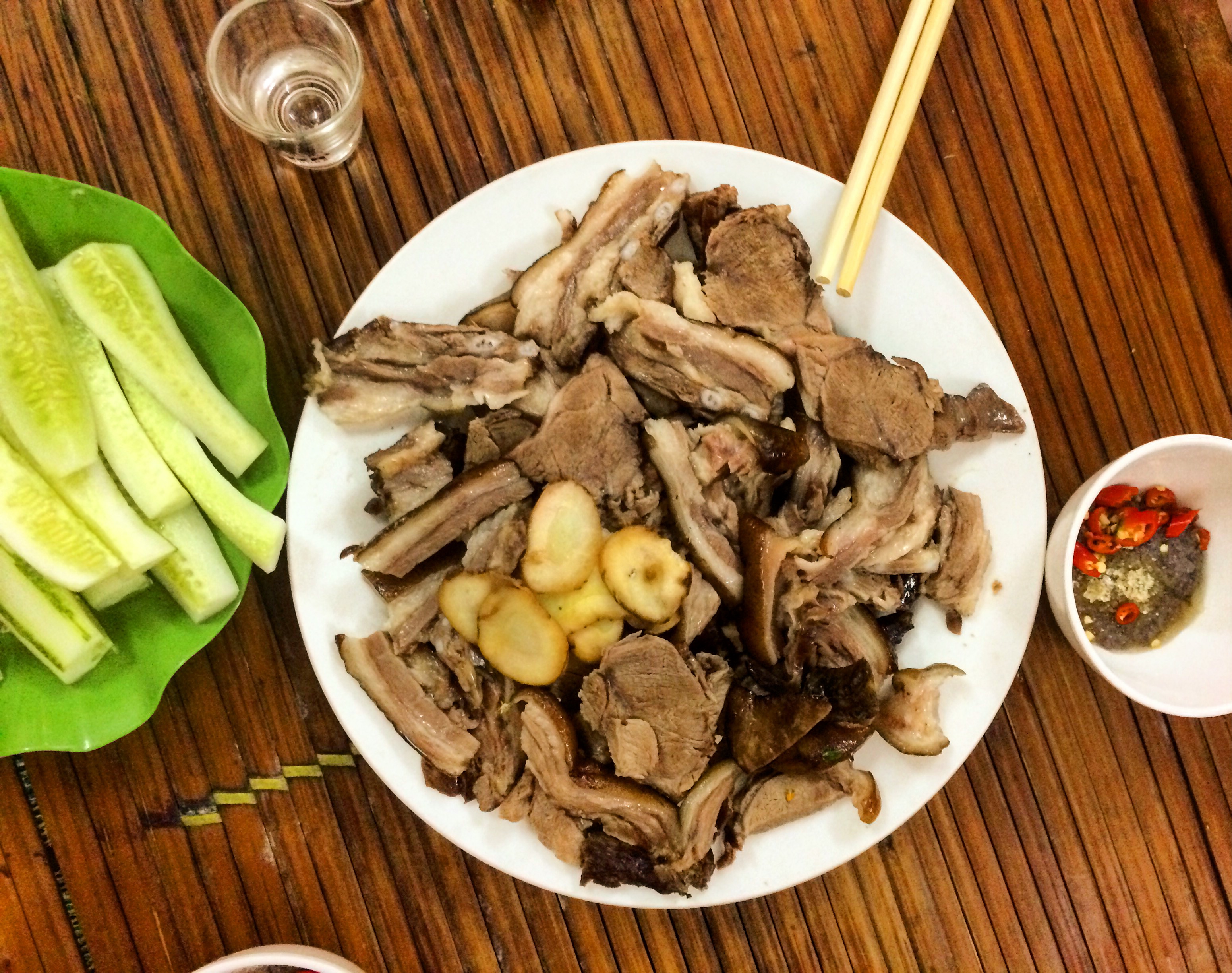

The use of ingredients typically uncommon or taboo in most countries is one of the quintessential attributes that make Vietnamese cuisine unique. While unusual ingredients can only be found in exotic restaurants in many countries, Vietnamese cuisine is deemed atypical in that the usage of these ingredients can play a customary role in daily family dishes regardless of social class.
A common and inexpensive breakfast dish that can be found in any wet market,
balut (''hột vịt lộn'') is a fertilized duck egg with a nearly developed
embryo
An embryo is an initial stage of development of a multicellular organism. In organisms that reproduce sexually, embryonic development is the part of the life cycle that begins just after fertilization of the female egg cell by the male spe ...
inside, which is boiled and eaten in the shell. It is typically served with fresh herbs:
''rau răm'', salt, and black pepper;
lime juice is another popular additive, when available. A more unusual version of balut dish—fetus quail (''trứng cút lộn'') is a snack favored by many Vietnamese students.
Paddy crab and paddy snail are the main ingredients in ''bún riêu ốc''—a popular noodle dish—and in some everyday soup dishes (''canh'') and braised food (''món bung''). Family meals with
silkworm
The domestic silk moth (''Bombyx mori''), is an insect from the moth family Bombycidae. It is the closest relative of '' Bombyx mandarina'', the wild silk moth. The silkworm is the larva or caterpillar of a silk moth. It is an economically ...
s (''nhộng''), banana flowers (''hoa chuối''), sparrows, doves, fermented fish and shrimp (''mắm cá'', ''mắm tôm'', ''mắm tép'') are not rare sights. Seasonal favorites include
ragworms (''rươi''), which are made into many dishes such as fried ''rươi'' omelet (''
chả rươi''), fermented ''rươi'' sauce (''mắm rươi),'' steamed ''rươi (rươi hấp),'' stir-fried ''rươi'' with radish or bamboo shoot ''(''
rươi xào củ niễng măng tươi hay
củ cải'').'' Three striped crab ''
(''ba khía)'''' is popular in several southern provinces, including ''
''Cà Mau'',
''Sóc Trăng'''' and ''
''Bạc Liêu''''; it is eaten fermented, stir-fried or steamed''.''
Northern Vietnamese cuisine is also notable for its wide range of meat choices. Exotic meats such as
dog meat
Dog meat is the flesh and other edible parts derived from dogs. Historically, human consumption of dog meat has been recorded in many parts of the world. During the 19th century westward movement in the United States, ''mountainmen'', native ...
,
cat meat
The cat (''Felis catus'') is a domestic species of small carnivorous mammal. It is the only domesticated species in the family Felidae and is commonly referred to as the domestic cat or house cat to distinguish it from the wild members of t ...
,
rat meat, snake,
soft-shell turtle, deer, and domestic goat are sold in street-side restaurants and generally paired with alcoholic beverages. A taboo in many Western countries and in southern Vietnam, consumption of dog meat and cat meat is common throughout the northern part of the country and is believed to raise the libido in men. Television chef
Andrew Zimmern visited northern Vietnam in the 12th episode of his popular show ''
Bizarre Foods with Andrew Zimmern''.
Cobra beating heart and dried bones, silkworms, and
bull penis are some of the dishes he sampled. He also tried
porcupine
Porcupines are large rodents with coats of sharp spines, or quills, that protect them against predation. The term covers two families of animals: the Old World porcupines of family Hystricidae, and the New World porcupines of family, Erethiz ...
.
Paddy
mouse
A mouse ( : mice) is a small rodent. Characteristically, mice are known to have a pointed snout, small rounded ears, a body-length scaly tail, and a high breeding rate. The best known mouse species is the common house mouse (''Mus musculus' ...
meat—barbecued, braised, stir- or deep-fried—is a delicacy dish that can be found in Southern Vietnamese rural areas or even high-end city restaurants.
Crocodile
Crocodiles (family Crocodylidae) or true crocodiles are large semiaquatic reptiles that live throughout the tropics in Africa, Asia, the Americas and Australia. The term crocodile is sometimes used even more loosely to include all extant me ...
s were eaten by Vietnamese while they were taboo and off limits for Chinese.
Shark fins
Sharks are a group of elasmobranch fish characterized by a cartilaginous skeleton, five to seven gill slits on the sides of the head, and pectoral fins that are not fused to the head. Modern sharks are classified within the clade Selachimor ...
are imported in massive amounts by Vietnam.
Anthony Bourdain
Anthony Michael Bourdain (; June 25, 1956 – June 8, 2018) was an American celebrity chef, author, and travel documentarian who starred in programs focusing on the exploration of international culture, cuisine, and the human condition. Bourda ...
, the host chef of
Travel Channel's ''
Anthony Bourdain: No Reservations'', wrote in April 2005: "...everything is used—and nothing wasted in Vietnam."
Animal parts that are often disposed of in many Western countries are used fully in Vietnamese cooking. Organs, including lungs, livers, hearts, intestines and bladders of pigs, cattle, and chickens are sold at even higher prices than their meat. Chicken
testicles
A testicle or testis (plural testes) is the male reproductive gland or gonad in all bilaterians, including humans. It is homologous to the female ovary. The functions of the testes are to produce both sperm and androgens, primarily testosteron ...
and undeveloped eggs are stir-fried with vegetables and served as an everyday dish.
Many of the traditional northern Lunar New Year dishes such as ''
thịt đông'', ''
giò thủ,'' and ''canh măng móng giò'' involve the use of pig heads, tongues, throats and feet. Pig and beef tails, as well as chicken heads, necks and feet, are Vietnamese favorite beer dishes. ''Bóng bì'', used as an ingredient in ''canh bóng''—a kind of soup, is pig skin baked until popped. Steamed pig brains can be found almost everywhere. Also in the northern part of Vietnam, different kinds of animal blood can be made into a dish called ''
tiết canh'' by whisking the blood with fish sauce and cold water in a shallow dish along with finely chopped, cooked duck innards (such as gizzards), sprinkled with crushed peanuts and chopped herbs such as Vietnamese coriander, mint, etc. It is then cooled until the blood coagulates into a soft, jelly-like mixture and served raw.
Coconut worms, or ''đuông dừa'', is a delicacy found widely in the
''Trà Vinh'' Province of Vietnam. They are the larvae form of the
palm weevil and are eaten live within a salty fish sauce with chili peppers.
Beverages
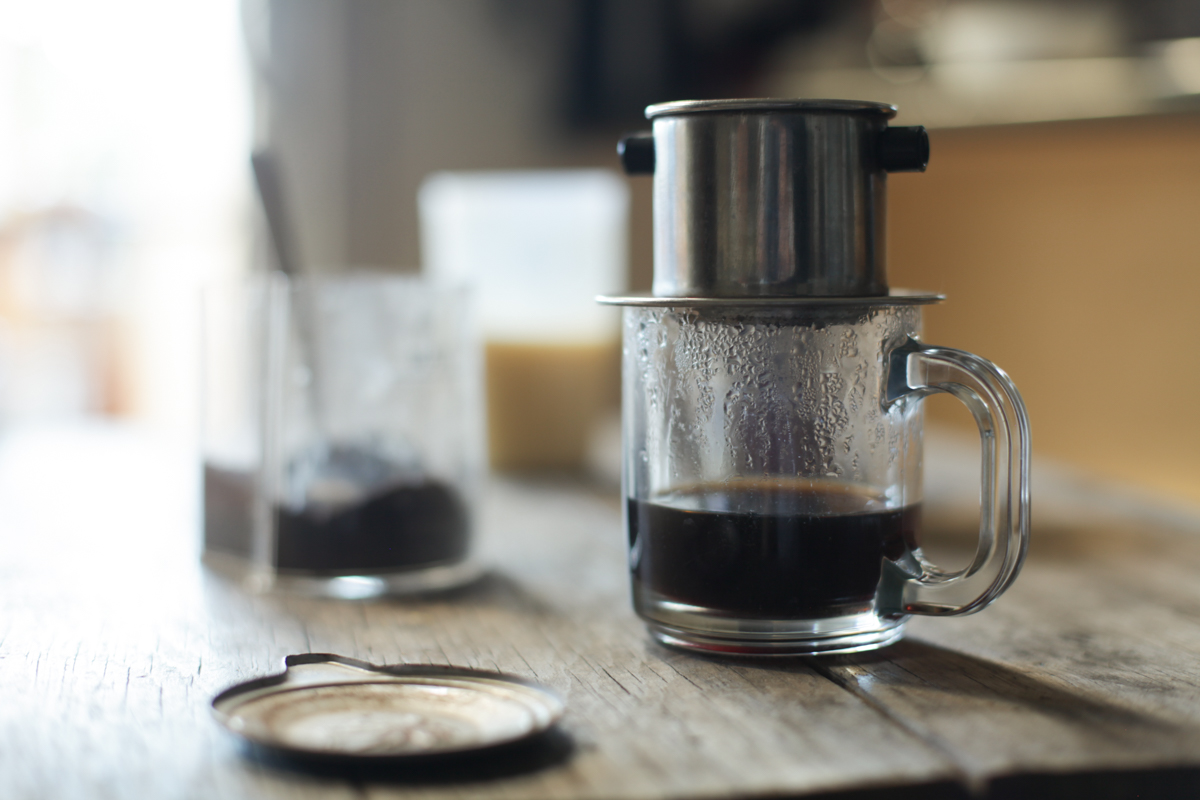

See also
*
List of Vietnamese dishes
This is a list of dishes found in Vietnamese cuisine.
Noodle dishes
Dumplings
Pancakes and sandwiches
Rolls and rice papers
Rice
Xôi
Soups and cháo (congees)
Other dishes
Sweet cakes and desserts
Condiments and sauces
...
*
List of Vietnamese culinary specialities
This is a list of culinary specialities in Vietnamese cuisine by provinces.
An Giang Province
* Khô cá lóc đồng
* Mắm thái Châu Đốc
* Bánh canh Vĩnh Trung, Tịnh Biên District
* Bò cạp chiên giòn, Bảy Núi mounta ...
*
List of Vietnamese ingredients
*
Vietnamese noodles
*
Vietnamese wine
Vietnamese wine is wine produced in Vietnam. The area was first cultivated for viticulture during the French colonial rule of the region in the late 19th century. The region's tropical climate was ill-suited for the type of ''Vitis vinifera'' tha ...
*
Rượu đế
''Rượu đế'' is a distilled liquor from Vietnam, made of either glutinous or non-glutinous rice. It was formerly made illegally and is thus similar to moonshine. It is most typical of the Mekong Delta region of southwestern Vietnam (its e ...
rice wine
*
Basa (fish)
*
Southeast Asian cuisine
References
Further reading
* Nguyen, Andrea Quynhgiao; Cost, Bruce (FRW); Beisch, Leigh. (2006
''Into the Vietnamese kitchen: treasured foodways, modern flavors'' Ten Speed Press
Ten Speed Press is a publishing house founded in Berkeley, California in 1971 by Phil Wood. Ten Speed Press was bought by Random House in February 2009 and is now part of their Crown Publishing Group division.
History
Wood worked with Barnes & ...
,
* Le, Ann; Fay, Julie. (2006
''The Little Saigon Cookbook: Vietnamese Cuisine and Culture in Southern California's Little Saigon'' Globe Pequot,
* Thị Chơi Triệu, Marcel Isaak, (1998
''The Food of Vietnam: Authentic Recipes from the Heart of Indochina'' Tuttle Publishing,
* McDermott, Nancie; Alpert, Caren (2005
''Quick & Easy Vietnamese: 75 Everyday Recipes''Chronicle Books,
* Chi Nguyen; Judy Monroe, (2002
''Cooking the Vietnamese way: revised and expanded to include new low-fat and vegetarian recipes''Twenty-First Century Books,
* Pauline Nguyen; Luke Nguyen; Mark Jensen (2007)
''Secrets of the Red Lantern: Stories and Vietnamese Recipes from the Heart''Murdoch Books,
* Thị Chơi Triệu, Marcel Isaak, Heinz Von Holzen (2005)
''Authentic Recipes from Vietnam''Tuttle Publishing,
* Hoyer, Daniel. (2009
Gibbs Smith,
{{DEFAULTSORT:Vietnamese Cuisine
Southeast Asian cuisine
Articles containing video clips


 Vietnamese cuisine encompasses the foods and beverages of
Vietnamese cuisine encompasses the foods and beverages of  Vietnamese cuisine is influenced by the Asian principle of five elements and '' Mahābhūta''.
Vietnamese cuisine is influenced by the Asian principle of five elements and '' Mahābhūta''.


 Vietnamese cuisine is reflective of the Vietnamese lifestyle, from the preparation to how the food is served. Going through long phases of war and political conflict, as well as cultural shifts, the vast majority of the Vietnamese people have been living in poverty. Therefore, the ingredients for Vietnamese food are often very inexpensive but nonetheless, the way they are cooked together to create a yin–yang balance makes the food simple in appearance but rich in flavor.
Because of economic conditions, maximizing the use of ingredients to save money has become a tradition in Vietnamese cooking. In earlier decades and even nowadays in rural areas, every part of a cow is used, from the muscle meat to the intestines; nothing is wasted. The higher quality cuts from farmed animals (cows, pigs) would be cooked in stirfry, soup or other dishes, while the secondary cuts would be used in blood sausages or soup. The same goes for vegetables like scallions: the leafy part is diced into small bits which are used to add flavor to the food while the crunchy stalk and roots are replanted.
(fish sauce) is the most commonly used and iconic condiment in Vietnamese cooking. It is made from fermented raw fish and is served with most of the Vietnamese dishes. Vietnamese cuisines are not known for ingredients with top quality, but rather for the very inexpensive and simple scraps that are creatively mixed to create dishes with bold flavor. A traditional southern Vietnamese meal usually includes (plain white rice), (
Vietnamese cuisine is reflective of the Vietnamese lifestyle, from the preparation to how the food is served. Going through long phases of war and political conflict, as well as cultural shifts, the vast majority of the Vietnamese people have been living in poverty. Therefore, the ingredients for Vietnamese food are often very inexpensive but nonetheless, the way they are cooked together to create a yin–yang balance makes the food simple in appearance but rich in flavor.
Because of economic conditions, maximizing the use of ingredients to save money has become a tradition in Vietnamese cooking. In earlier decades and even nowadays in rural areas, every part of a cow is used, from the muscle meat to the intestines; nothing is wasted. The higher quality cuts from farmed animals (cows, pigs) would be cooked in stirfry, soup or other dishes, while the secondary cuts would be used in blood sausages or soup. The same goes for vegetables like scallions: the leafy part is diced into small bits which are used to add flavor to the food while the crunchy stalk and roots are replanted.
(fish sauce) is the most commonly used and iconic condiment in Vietnamese cooking. It is made from fermented raw fish and is served with most of the Vietnamese dishes. Vietnamese cuisines are not known for ingredients with top quality, but rather for the very inexpensive and simple scraps that are creatively mixed to create dishes with bold flavor. A traditional southern Vietnamese meal usually includes (plain white rice), ( Daily meals of Vietnamese people quite differ from Vietnamese foods served in restaurants or stalls. A typical meal for the average Vietnamese family would include:
* ''Cơm trắng'': Cooked white rice
* ''Món mặn'' or main dishes to eat with rice: Fish/seafood, meat, tofu (grilled, boiled, steamed, stewed or stir-fried with vegetables)
* ''Rau'': Sauteed, boiled or raw fresh green vegetables
* ''Canh'' (a clear broth with vegetables and often meat or seafood) or other kinds of soup
* ''
Daily meals of Vietnamese people quite differ from Vietnamese foods served in restaurants or stalls. A typical meal for the average Vietnamese family would include:
* ''Cơm trắng'': Cooked white rice
* ''Món mặn'' or main dishes to eat with rice: Fish/seafood, meat, tofu (grilled, boiled, steamed, stewed or stir-fried with vegetables)
* ''Rau'': Sauteed, boiled or raw fresh green vegetables
* ''Canh'' (a clear broth with vegetables and often meat or seafood) or other kinds of soup
* '' A feast ( vi, cỗ, ) is a significant event for families or villages, usually up to 12 people for each table. A feast is prepared for weddings, funerals, and festivals, including the longevity wishing ceremony. In a feast, ordinary foods are not served, but boiled rice is still used.
A Vietnamese feast has two courses: the main course ( – salty dish) and dessert ( – sweet dish). All dishes, except for individual bowls of rice, are enjoyed collectively. All main course dishes are served simultaneously rather than one after another. The major dish of the main course is placed in the center of the tables, usually big pots of soup or a hot pot.
A basic feast () consists of 10 dishes: five in bowls (): (fried fish belly), (
A feast ( vi, cỗ, ) is a significant event for families or villages, usually up to 12 people for each table. A feast is prepared for weddings, funerals, and festivals, including the longevity wishing ceremony. In a feast, ordinary foods are not served, but boiled rice is still used.
A Vietnamese feast has two courses: the main course ( – salty dish) and dessert ( – sweet dish). All dishes, except for individual bowls of rice, are enjoyed collectively. All main course dishes are served simultaneously rather than one after another. The major dish of the main course is placed in the center of the tables, usually big pots of soup or a hot pot.
A basic feast () consists of 10 dishes: five in bowls (): (fried fish belly), ( In the Nguyễn dynasty, the 50 best chefs from all over the kingdom were selected for the board to serve the king. There were three meals per day—12 dishes at breakfast and 66 dishes for lunch and dinner (including 50 main dishes and 16 sweets). An essential dish was bird's nest soup (). Other dishes included shark fin (),
In the Nguyễn dynasty, the 50 best chefs from all over the kingdom were selected for the board to serve the king. There were three meals per day—12 dishes at breakfast and 66 dishes for lunch and dinner (including 50 main dishes and 16 sweets). An essential dish was bird's nest soup (). Other dishes included shark fin (), 



 Vietnamese cuisine boasts a huge variety of noodle soups, each with distinct influences, origins and flavours. A common characteristic of many of these soups is a rich broth.
Vietnamese cuisine boasts a huge variety of noodle soups, each with distinct influences, origins and flavours. A common characteristic of many of these soups is a rich broth.





 '' Bánh tráng'' can be understood as either of the following:
* ''Bánh tráng cuốn''
: Thin rice flour sheet dried into what is commonly called "rice paper", used in making spring roll ('' chả giò''), and summer rolls ('' gỏi cuốn'') by applying some water to soften the texture
* '' Bánh tráng nướng'' (in the south), or ''bánh đa'' in the north
: These are large, round, flat rice crackers, which, when heated, enlarge into round, easily shattered pieces. They can be eaten separately, although they are most commonly added into the
'' Bánh tráng'' can be understood as either of the following:
* ''Bánh tráng cuốn''
: Thin rice flour sheet dried into what is commonly called "rice paper", used in making spring roll ('' chả giò''), and summer rolls ('' gỏi cuốn'') by applying some water to soften the texture
* '' Bánh tráng nướng'' (in the south), or ''bánh đa'' in the north
: These are large, round, flat rice crackers, which, when heated, enlarge into round, easily shattered pieces. They can be eaten separately, although they are most commonly added into the 


 Vegetarian dishes in Vietnam often have the same names as their meat equivalents, e.g. ''phở bò,'' but with ''chay'' (vegetarian) sign in front, those dishes are served with tofu instead of meat. Nearly every soup, sandwich and street food has its vegetarian correspondent. Sometimes you can also see notations like ''"phở chay"'', ''"bánh mì chay"'' (vegetarian sandwich) or ''"cơm chay"'' (vegetarian rice). Vegetarian food in comparison the normal dishes are almost always cheaper, often half of the normal price. Vegetarian restaurants are mostly frequented by religious Vietnamese people and are rarely found in touristic areas. Vegetarian food is also eaten to earn luck during special holiday and festival, especially during Lunar New Year where Vietnamese culture serve vegetarian food regardless of their religion.
Vegetarian dishes in Vietnam often have the same names as their meat equivalents, e.g. ''phở bò,'' but with ''chay'' (vegetarian) sign in front, those dishes are served with tofu instead of meat. Nearly every soup, sandwich and street food has its vegetarian correspondent. Sometimes you can also see notations like ''"phở chay"'', ''"bánh mì chay"'' (vegetarian sandwich) or ''"cơm chay"'' (vegetarian rice). Vegetarian food in comparison the normal dishes are almost always cheaper, often half of the normal price. Vegetarian restaurants are mostly frequented by religious Vietnamese people and are rarely found in touristic areas. Vegetarian food is also eaten to earn luck during special holiday and festival, especially during Lunar New Year where Vietnamese culture serve vegetarian food regardless of their religion.

 Vietnamese use fruits in season. When the season is passing, they make candied fruit, called ''ô mai'', and fruit preserves, called ''mứt''. The original taste of ''ô mai'' is sour, sweet, salty, and spicy. The most famous kind of ''ô mai'' is ''ô mai mơ'', made from
Vietnamese use fruits in season. When the season is passing, they make candied fruit, called ''ô mai'', and fruit preserves, called ''mứt''. The original taste of ''ô mai'' is sour, sweet, salty, and spicy. The most famous kind of ''ô mai'' is ''ô mai mơ'', made from 


